The Lim Hock Seng Family
An update:
On the morning of Sunday, June 22 ’14, Raymond Goh was on his usual weekend exploration of Bukit Brown when he came across the tomb of Ngo Kim Neo who died young at 22 years old in 1927.
On her tomb was inscribed, she was the wife of Lim Hock Seng (see the original story below) and she left behind 4 children, Sons: Lim Cheng Chuan and Lim Cheng Ean; Daughters: Lim Khoon Neo (Lucy) and Lim Geok Kiat.
What was intriguing was the name of Lim Cheng Ean which was included in the inscription as her son, as he was born in 1934, 7 years after the death of Madam Ngo Kim Neo.
We emailed the daughter of Lim Cheng Ean to inform her of the find and if she could throw some light on the matter.
This was her reply:
“I have managed to gather some brief knowledge about Ngo Kim Neo from my mother. Apparently Lim Hock Seng married 2 sisters. The first died very young without children and her grieving parents offered their second daughter, who must be Ngo Kim Neo, to him. She had 2 daughters and then sadly died giving birth to my father’s older brother, Lim Cheng Chuan, who was known in the family as the ‘Tiger Baby’ because he ‘ate his mother while being born’ (1927 was indeed the year of the tiger) . I’m not sure if this is a Chinese superstition, or just a Lim family ‘fable’. My father will be so moved to see the photo that I am posting to him today. I doubt he has ever seen the grave, or his own name credited as her son on the tombstone. His sister, Lucy (Lim Khoon Neo), was very close to him ” Gillian Mendy nee Lim, 23 June’2014
Gillian further explained that, her father’s (Lim Cheng Ean) mother was Lim Hock Seng’s third wife, Khoo Ah Tho, brought from Penang to marry him and look after the 3 young children left behind by Ngo Kim Neo.
From Gillian’s information, we gleaned that after Lim Cheng Ean was born, the tombstone of Madam Ngo was replaced to include his name to acknowledge Madam Ngo as his mother. We are not sure what customary practice led to this, or maybe it was a husband’s last loving tribute to the wife who bore him 3 children before she passed away at childbirth at the tender age of 22.
In sharing with us the close relationship her father had with his half sister, Lucy Lim Khoon Neo, Gillian attached an article on her aunt’s wedding and another line of family connection was revealed. Lucy Lim married Cheong Thiam Siew, Chairman of Frank Knight, who was the son of Cheong Hock Seng, and grandson of Cheong Koon Seng Her husband came from an illustrious and blue-chip line of property auctioneers.
And finally Gillian shared that her father who was in a fragile state of health when she first wrote to us in in January of this year, has improved and just celebrated his 80th birthday. The family put together a scrap book of his Lim ancestors, and the photos we had sent earlier of his father’s and his grandparent’s graves at Bukit Brown was the centerpiece of the book.
*****
All Things Bukit Brown received an email this morning (14 January) addressed to Raymond Goh. It was from Gillian Mendy (Lim) from London, asking if her grandfather’s Lim Hock Seng’s grave was affected by the highway. Her email read:
“Your Bukit Brown website is incredibly informative and interesting. We have only just discovered about the planned road works through the cemetery.
My grandfather is buried at Bukit Brown and we are trying to find out if his grave is affected by the road project. The family now live in England. If it is affected then we would come to Singapore to claim the remains.
A personal account by Aylwin Tan who witnessed the exhumation of his grandfather and aunt at Bukit Brown on the morning of Wednesday, 8th January,2014.
***
I received a phone call from the exhumation office about 1.5 hours after I had registered. Picked my Dad up and went directly to the gravesite.
The green tentage is that of my aunt Tan Siok Hwa (aged 10) and the grey is my grandpa, Tan Cheng Moh. Both were killed during a Japanese raid; a bomber scored a direct hit on the bomb shelter where my grandpa had put his entire family, including his close relatives. Apparently, grandpa’s thinking was that they should all stick together and if they all died, so be it.
Their funerals were carried out in haste. A number of traditions were abandoned for fear of being caught out in the open by the Japanese bombers e.g. mourners alighting to perform rites at every bridge along the way to the burial ground.
Mr Lee (the gentleman in yellow boots seen in the first photo) told me that the coffins and remains had disintegrated and had merged with the soil. Not surprising, given that they had passed about 70 years ago. The gravediggers gathered some earth and put it in plastic bags for the purposes of cremation.
I was curious to know how the gravediggers knew that they had dug deep enough to reach the remains. Mr Lee explained that the gravediggers would know once they reached a flat surface as this was the bottom of the coffin.
The gravediggers were also able to tell that my aunt died when she was a child. If you look at my aunt’s grave, you can see a ‘step’ indicating that the coffin was shorter than an adult’s.
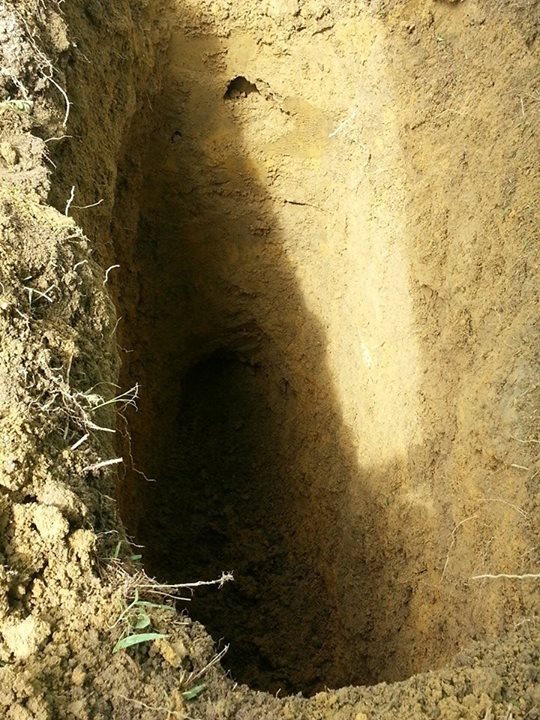
The grave of grandfather dug until a flat even surface was reached, where the coffin had been laid (photo Aylwin Tan)
I was worried that Dad would not be able to negotiate the uneven terrain to the grave sites but the path worn out by the gravediggers proved manageable. Mr Lee told me that these gravediggers are the last of their kind in Singapore.
Dad spent some time telling his story to the gravediggers while I sorted out with Mr Lee the items found in the graves. Dad’s chair was provided by Swee Hong, the company that won the exhumation tender, a testimony to their planning and attention to detail. Also, you can see how they used the umbrellas to shield the boxes from the sun.

Umbrellas shading the remains from the sun as required by traditional practices. Aylwin’s father (seated) chatting with the grave diggers (photo Aylwin Tan)
The gravediggers recovered a chain and part of a bowl from my aunt’s grave. The bowl was probably used in the funeral rites. Mr Lee asked if I would donate them for research. I shall have to ask my elders’ permission first.
My grandpa’s grave yielded a bullet and a piece of metal which looked like a cone with the top portion cut off. I had to surrender the bullet as it was not a spent round. The gravediggers surmised that the metal piece came from the bomb but I wonder where the bullet came from. Dad said that the metal piece was not the cause of grandpa’s death; a beam had fallen on grandpa’s head and cracked it open. Death was instantaneous. The sight must have been extremely traumatic for the family. Dad was only 11 or 12 then.
One unexpected development came about when Dad suddenly said that my great grandfather was also buried somewhere in Bukit Brown. Dad did not know his name or the location of the grave site. Apparently, only one of grandpa’s brothers had this information and he had since passed. According to Mr Lee, great grandpa’s remains will be exhumed and disposed of if unclaimed after a period. Mr Lee also said that there was still hope if someone in my family could remember great grandpa’s name as the tombstone would surely state grandpa’s name. I’ll try my best to ask my relatives but am not very hopeful.
I will miss the 2 “Yodas” guarding grandpa’s grave. The other 2 guards look kind of effeminate.
The left panel of the tombstone lists grandpa’s sons and daughters. Dad is ‘Geok San‘, which means ‘jade mountain’ in Chinese. In accordance with Chinese tradition, the sons and male cousins in the same generation have the same identifying name. In my Dad’s generation, the name is ‘Geok‘. In mine, it is ‘Wee’, which means ‘great‘ in Chinese. I understand that these names are predetermined by the Chinese Almanac.
The exhumation ended on a quiet note. After I had given written confirmation of the items from the graves that I had retained, I was given printed photographs of the two grave sites and that was it.
I was very impressed with the professionalism of the Swee Hong staff. They were attentive to my requests and sensitive to religious aspects of the exhumation. They worked fast but were in no hurry, allowing claimants all the time they needed to carry out their religious observances. Thanks to them, the exhumation process went smoothly.
– Aylwin Tan-
Additional Information : Both grandfather and aunt died on 18 Jan 1942.
Grave of Tan Cheng Moh 陳青茂 #769 (photo credit The Bukit Brown Cemetery Documentation Project )
Grave of Tan Siok Hwa 陳淑華 #763 (photo credit The Bukit Brown Cemetery Documentation Project)
Editor’s note: We would like to thank Aylwin Tan for giving us permission to reproduce his personal account on the blog. If you are a descendant who has ancestors staked for exhumation, please share your story with us.
Email us: a.t.bukitbrown@gmail.com
by Sugen Ramiah
While exploring Hill 4, I stumbled upon a tomb of a young man, by the name of Ee Tean Choon.(E Tean Choon on tombstone)
It was very unique because the tomb was of a modern design in marble. And so I started a little research on his family in early November 2013. It was on the 31st of December 2013, while strolling with brownies Peter and Ee Hoon, that I was told that there was another art deco tomb, similar to that of Ee Tean Choon that also belonged to the Ee family, his grandparents. Here’s what I have traced of the Ee Tean Choon family tree.
Grandparents: Ee Swee Hin and Khoo Swee Yee
Ee Swee Hin passed away on the 8th September 1942 and his wife Khoo Swee Yee, on the 19th February 1955. They are buried together in Hill 5 Division B with LTA tag #1122 and will be exhumed in March.
Father: Ee Yean Keat
Ee Yean Keat was the eldest son of Ee Swee Hin and Khoo Swee Yee. He had two other siblings, Ee Yean Bee and another adopted brother – Tan Eng Yam. Born in Malacca in the year 1884, he was educated in a high school there and came to Singapore to look for a better future. He married Seow Joo Neo and had seven children. He first started work with Netherlands Trading Society in 1904. After 6 years, in 1910, he worked as a cashier with the KPM shipping company. He wanted an early retirement after 25 years with the shipping company. However, he later joined the Straits Times Press (Malaya) Ltd and officially retired in 1959 at the age of 75. He was also known as the “Grand Old Man’ of the accounts section of Straits Times Press (Malaya). He passed away on the 24th of September 1968 at the age of 84. The Obituary section in the archives indicates that he left behind 2 wives. Seow Joo Neo the mother of Ee Tean Choon, passed away on the 4th of January 1985 at the age of 102. She left behind 19 grandchildren and 16 great grandchildren. No information has been uncovered about Ee Yean Keat’s other wife.
Ee Tean Choon (E Tean Choon on tombstone)
Ee Tean Choon born in the year 1910 and was the first born of Ee Yean Keat and Seow Joo Neo of No.350 East Coast Road. He was the eldest of seven children. He married Ruby Chia Boey Neo , the fifth daughter of Mr & Mrs Chia Keng Chin of No.8 Saint Thomas Walk, on the 3rd of October 1936. Chia Boey Neo the grand-daughter of Mr Chia Hood Theam, was born in July 1914 and was 22 years old when she married Ee. They didn’t have their own children but adopted two babies -Willie Ee Kean Leong and Margaret Ee.
Sadly, Ee Tean Choon died of typhoid, on the 3rd of April 1938, at just 28 years old. He left behind a young widow and two infants, barely two years after his marriage. The two infants were then adopted by his brother, Ee Tean Cheng and the young widow returned to her parents’ house.
Inscribed on the tomb is an epitaph :
‘In the prime of his life death claimed him, In the pride of his manhood days, none knew him but to love him, None mention his name but with praise.’
I believe that the epitaph was taken from ‘The life of Rev. William James Hall, M. D.: Medical Missionary on the slums of New York, Pioneer Missionary to Pyong Yang, Korea’ 1897. It is about how Rev Hall ministered to the sick and wounded of Korea and his martyrdom. Coincidentally, both William (Willie for short) Willie and Margaret, were the names of Dr. Hall’s great grandparents.
Ee Tean Choon is buried in Hill 4 Division C with LTA tag #2612. He has been claimed by the family of his wife, the late Mdm Chia Boey Neo.
Brother : Ee Tean Cheng
Ee Tean Cheng was actively involved in many athletic associations such as the Useful Lads Badminton Party, Horlicks Badminton Party and was elected as vice president of the S.A.S.U (Singapore Armature Sports Union) in 1940. The tournaments, training and meetings were often held in the badminton court of the Ee’s residence at East Coast Road. He worked for Ford Motors and married to Ong Lian Neo Nellie on the 15th December 1940. Unfortunately, she passed away on the 26th October 1941 while in labour, both mother and child didn’t survive. She was buried in Bukit Brown and Raymond Goh has a blog post on her life here
Ee Tean Cheng had a second marriage to Lily Oon Siok Neo. They had a son, Winston Ee Kean Leng and also adopted the late Ee Tean Choon’s children – Willie and Margaret. He had five grandchildren. He passed away on 3rd April 1999, coincidentally the anniversary of his brother, Ee Tean Choon ( 3rd April 1938)
Brother: Ee Tean Chye
Colonel Ee Tean Chye was the first Commander of the Singapore Air Defence Command and in 1972, the first Chief of Air Force of the Republic of Singapore Air Force. He has three children, Patricia Ee, Laura Ee and Christopher Ee.
Son: Willie Ee Kean Leong
Willie Ee Kean Leong was the director of Sankyo Seiki Singapore Pte Ltd. He married Lim Eng Hong, eldest daughter of Mr Lim Kim San, former cabinet minister and first chairman of HDB. They had two children, Ee Kuo Ren and Ee Yuen Ling.
Daughter: Margaret Ee
Margaret Ee married Mr Richard Png and had two children, Dr Kenneth Png and Keith Png.
Postscript : Unfortunately both grandparents and grandson will be moving house to make way for the new highway. However both grandparents and grandson will be interned in the same block in Choa Chu Kang Columbarium. This is just another story of another ordinary family that has contributed to this country. May they rest in Peace.
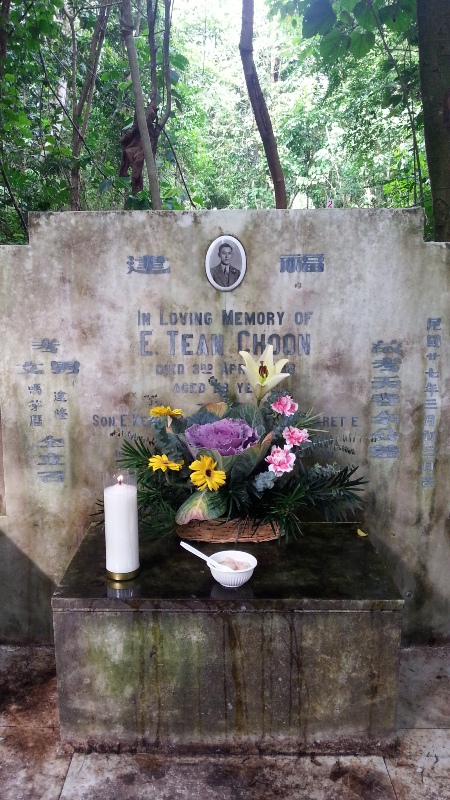
Offerings for Ee Tean Choon on the day of the Winter Solstice 21 December 2013, prepared by brownies Choo Ai Loon and Sugen Ramiah (photo Sugen Ramiah)
Sugen Ramiah is a teacher by training and his interest includes observing and documenting Chinese festivals and rituals conducted by temples. This is his first foray into researching family trees.
Read his blog posts on Salvation for Lost Souls here and here
References for Ee Family
The life of Rev. William James Hall, M. D. : medical missionary to the slums of New York, pioneer missionary to Pyong Yang, 1897. (E-book) Emmanuel College Library, Victoria University
Announcement. (1936, June 23). The Straits Times
Tean Cheng-Ong. (1940, December 16). The Singapore Free Press and the Mercantile Advertiser
Deaths. (1941, October 26). The Straits Times
Cashier, 75, Retires for Second Time. (1959, December 31). The Singapore Free Press
Deaths. (1968, September 25). The Straits Times
Deaths. (1985, January 5). The Straits Times
Condolences. (1994, September 4). The Straits Times
Deaths. (1999, April 4). The Straits Times
Deaths. (2000, June 20). The Straits Times
The Air Force, Singapore : Republic of Singapore Air Force, 1988
Controlled Growth Restriction Policies For Certain Closed Food-Chain Systems by Patricia G. M. Ee 1992. Simon Fraser University, April 1992.
A call was made to the community to provide feedback to the Ministry of National Development (MND), to preserve Bukit Brown as a heritage site for future generations in the draft Master plan 2013. The closing date for feedback is 19th December 2013. For those who don’t know how to begin, there is a template available to guide you here. We encourage you to copy the email to your MP.
To those who have written, We Thank You. Some of you have shared your letters with us. We gratefully reproduce extracts with your kind permission, with the hope it will inspire others to write in and give their feedback.
If you wish to share your feedback with the community, please bcc your letter to MND to a.t.bukitbrown@gmail.com
———————————————————————————————————————————————————–
“We are custodians of our country’s heritage not just for ourselves but for our future generations. It is important that they continue to see for themselves how respect is being shown to our forebears and learn the very real lesson of conserving our roots even, or especially in the face of rapid urban development. Precious “history lesson materials” like Bukit Brown, once lost, may never be recovered. Let no regret come about.”
***
Eugene Tay
“The biggest threat to Singapore is apathy, and when Singaporeans do not feel a sense of belonging and are not bothered with what goes on here, then Singapore is in trouble. For Singapore to survive and prosper in the long term, it is necessary to have more opportunities in preserving our shared memories and creating our shared vision. And preserving Bukit Brown is an excellent opportunity that enables Singaporeans to feel that they belong here by remembering our past and creating our future.
Bukit Brown tells the stories of our forefathers who built Singapore, and creates opportunities for history education and discovery. The cemetery connects Singapore’s past and present, and allows us to understand that Singapore’s success is built up by our forefathers’ sweat and tears, and should not be taken for granted. We should preserve Bukit Brown because it helps us remember our past and keeps us rooted to Singapore.
Bukit Brown presents the opportunity for transforming the cemetery into a world-class living outdoor museum or heritage park. If this transformation adopts a bottom-up approach and with stakeholder engagement, it would allow us to come together, plan and work towards a future Singapore where heritage, nature and our economic needs can co-exist. We should preserve Bukit Brown because it enables us to work together and build bonds and resilience, and to create a space where our children and their children can enjoy and be proud of.
Singapore is a young nation and needs more common spaces like Bukit Brown to remind us how we got here and why this is home, and to create opportunities for building our future social resilience.”
Joyce Chew
“I am a fourth generation Singaporean. My great-grandfather, Chew Boon Lay, was one of Singapore’s very important pioneers.
In April 2012, my parents and I, along with my husband who is English, and our 2 children, discovered where my great-grandfather was buried in Bukit Brown. Thanks to a Straits Times journalist who did a photo-editorial on several important pioneers’ descendants, a photo shoot was conducted at the site of Chew Boon Lay’s tomb.
My parents who had not been to his tomb in more than 20 years came along as well, as did many of my extended family of cousins, uncles, and other relatives. Despite my parents both being aged and not able to walk or see well, they both made the uphill trek to Chew Boon Lay’s tomb in the dark as a huge storm was looming. That was such an important day for them and my family. I was re-acquainted with many relatives and met some whom I had never even met before. We have had several family gatherings since and as such, our April 2012 ‘reunion’ at Chew Boon Lay’s tomb in Bukit Brown served as a very important point of re-connecting with long lost relatives.
My father who is 83 was so elated to have been able to visit his grandfather’s tomb and pay respects to him again after such a long period of time. He was even happier to meet his many nieces, nephews, grand-nieces and grand-nephews, many of whom he had never met before. My siblings live abroad and when they returned to Singapore, I brought them to my great-grandfather’s tomb. All of them were so amazed at how peaceful and beautiful Bukit Brown is, but more importantly they were so happy to be able to visit our great-grandfather’s tomb for the first time.
Having reconnected with my Singapore roots via my great-grandfather’s tomb, I feel so proud to be a 4th generation Singaporean of an important Singapore pioneer who had such humble beginnings and contributed much to Singapore’s growth and prosperity. My children are both Singaporean and English and I want them to grow up feeling connected to Singapore and to be able to trace their roots in Singapore back to my great-grandfather. It was important for me that they visit his tomb and pay respects to their great-great-grandfather and to feel proud to be his descendants. I want them to be able to do this when they are older and when I am no longer around….such a connection in our young country that is forever trying to modernize and improve itself is, for me, one of the most important things if we want our children to have roots in, and feel connected to, Singapore.”
***
Other than the Bukit Timah Nature Reserves, Bukit Brown is a another place where I can bring my families out to Experience nature in a SAFE environment. National Parks are wonderful but they do not give the sense of one totally immersing in Nature.
“We are in a jungle.” my 6 year old boy Isaac said that with excitement when I brought him to the Bukit Brown. We have built too many shopping malls and what values are we cultivating when weekend we see Singaporeans crowding the malls and yet complaining that we are bored to death? Our souls are not fed with Nature but shopping malls and how would that make us as a Nation? We fly out of the country during school holidays to visit other country’s nature while we are destroying one in our own backyard? An article written by a 12 year old lavanyaprakash on Bukit Brown reminded me how important it is to preserve such AUTHENTIC nature and to educate Singaporeans on Nature Outings. I want my children’s generations to be able to experience this Nature and not just Bukit Timah Reserves or other man made National Parks. Thus, not only it is a National Heritage to be preserved, it is a World Heritage to be preserved!”
Other than the Bukit Timah Nature Reserves, Bukit Brown is a another place where I can bring my families out to Experience nature in a SAFE environment. National Parks are wonderful but they do not give the sense of one totally immersing in Nature. “We are in a jungle.” my 6 year old boy Isaac said that with excitement when I brought him to the Bukit Brown. We have built too many shopping malls and what values are we cultivating when weekend we see Singaporeans crowding the malls and yet complaining that we are bored to death? Our souls are not fed with Nature but shopping malls and how would that make us as a Nation? We fly out of the country during school holidays to visit other country’s nature while we are destroying one in our own backyard? An article written by a 12 year old lavanyaprakash on Bukit Brown reminded me how important it is to preserve such AUTHENTIC nature and to educate Singaporeans on Nature Outings. I want my children’s generations to be able to experience this Nature and not just Bukit Timah Reserves or other man made National Parks. Thus, not only it is a National Heritage to be preserved, it is a World Heritage to be preserved!”
***
Ang Hock Chuan
“As recently as September 2011, Bukit Brown was just another cemetery to me. I only remember it as the place I learnt to drive and as the place my grandfather was buried.
My father visited his father’s tomb every Ching Ming till an illness made it difficult for him to walk in that terrain. He had prepared for the eventuality of exhumation and already bought a niche for my grandfather. Unfortunately, I stopped following my father to visit years ago and forgotten where my grandfather was buried.
When my father passed away a few years ago, I became interested to look for my grandfather’s tomb. It would be the last thing I could do for my father to ensure his father’s remains are properly taken care of.
When I heard the news about the proposed highway, there was an urgency to locate my grandfather. I started to search for people who can help me locate him and stumbled on a group of volunteers sharing about Bukit Brown.
My initial interest was to look for my grandfather’s tomb and determine if it would be affected so I can make the necessary arrangements to relocate him.
I joined their guided tours in October 2011. That opened up my eyes to the rich heritage and history contained in Bukit Brown.
Over many visits I was also introduced to the rich bio-diversity and wildlife thriving in this habitat. Whilst I enjoyed listening to the birds in the woods, I was never an avid bird-watcher. But now, I keep a look out for the birds when I am there. I have seen uncommon and endangered species like the Changeable Hawk Eagle, the Red Jungle Fowl, the Greater Coucal and still learning each day about the special flora and fauna of Singapore there.
Bukit Brown turned into a living museum and classroom for me. History came alive. Our cultural heritage is enshrined here. A rich bio-diversity thrives here. It has an aesthetic beauty not found in our man-made parks. I count it my good fortune to have learnt about and visited this wonderful piece of our heritage before any wanton destruction takes place.
For these reasons and more, I hope to see Bukit Brown preserved, for our children’s and grandchildren’s sake. Once lost, lost forever.”
***
Alvin Lee
“We need not look any further than to Bukit Brown when we try to form our Singapore Identity because it is there for all to see. It is a living museum of our rich history that reminds us that our forefathers were migrants from various lands who decided to root themselves here in the Straits Settlement of Singapore, and we are their proud offspring. The fact that Singapore started as a migrant nation also helps us understand and welcome those who come here today, like our forefathers, to seek their fortune and make Singapore their home.”
Arielle Ng Rae
As a local student and youth, I finally took the time out today to join one of the tour groups organised by SOS Bukit Brown today, which I have been wanting to do ever since my ‘A’-levels finished. I was pleasantly surprised with the beauty and heritage of the site, but I was also incredibly saddened. The tour guides were very passionate and knowledgeable about local heritage, and the knowledge I gained today about Singapore and its roots, about how the locals worked together with a myriad of other races to form modern Singapore, about the roots of our unique culture that we often take for granted, made me the proudest of Singapore that I have ever been.
Through the tour, I finally appreciated exactly what it meant to be a melting pot of diverse cultures– how our customs came to be and as a result, how unique we are, and, ironically, the beauty of globalization in contributing to our shared heritage.
I plead with the most earnest and sincere heart, that you will protect Bukit Brown, for the sake of Singaporeans, who are fast becoming disillusioned with this city-state. This tour has done nothing but cement my love for Singapore and my pride for it, and I want many of my peers to feel the same. It is perhaps the natural state of the cemetery, and the untouched beauty of the landscape that lent this genuine connection and pride, but whatever it is, Bukit Brown cemetery has proven to be a beautiful reminder of what it once meant to be Singaporean, and what it could mean for future generations to come.
***
Ian Chong
“Bukit Brown has helped me achieve a better understanding of a history of a part of Singapore’s local history, and has helped me gain a stronger sense of where our nation has come from as a community. It is a reminder of where our society came from and the sacrifices earlier generations made. I hope my children will be able to experience the sheer physicality of our roots, as well as Singapore’s natural heritage. The flooding in Singapore over the past few years, including the Bukit Timah and Thomson areas that are downhill from Bukit Brown, reminds me of the importance of having natural green spaces near already built-up areas.
Moreover, during the periods of heavy haze earlier in 2013, green areas like Bukit Brown were least affected. Singapore needs natural green lungs like Bukit Brown.”
***
Casey Ong
“It is OUR oldest part of history. My grandfather’s grave at Bidadari was long gone more than 10 years ago to clear his “resting place” for more housing developments. Passing by that stretch of road gives us no connection anymore. Even though we have never met our grandfather before, we used to pop by his grave as a kid just to say “hello”, or just to remember how he looked like before by the photo on his grave. We felt the root of our roots. We felt proud of ourselves in some way too because of where we came from. Now I understand why history is such an important part of life.
So, please do not do to the oldest cemetery in Singapore, the Bukit Brown Cemetery what the government had already done at Bidadari. How much more land or our past that you want to “sacrifice” for economic development? Bukit Brown CAN BE an economic source if it can be converted to a tourist area, natural reserve etc. We do not want more roads, please.”
***
Kerry Cracknell
“I am a British citizen who has settled in Singapore with my family and now call it home – and I am proud to do so. My daughter was born here and we are happy here. However, my husband and I are trying to teach our children about the importance of preserving our environment and our natural heritage. We often tell them “once it’s gone, you can’t get it back” and we quote the Native American Cree prophecy “When all the trees have been cut down, when all the animals have been hunted, when all the waters are polluted, when all the air is unsafe to breathe, only then will you discover you cannot eat money”. It is heartbreaking to think that in a few years’ time, such a place as Bukit Brown – with its natural, historical and cultural significance – might be concreted over. Please, please consider saving it for our future generations.”
***
Philip Chai
While I have only set foot on Bukit Brown once, I am fascinated by the deep treasure trove of history it is. It is an unbias holding place of history as alot of our ancestor laid to rest. I remembered when I was young, I have to walk through Choa Chu Kang and there was this cemetery that fascinated me as it has very interesting tombs. I never get around to know it as it made way to development since. It would be a pity if we keep making concession on preservation in the name of progress as that would be a very up-rooting experience. No pictures or archive can replace the actual tombstone and the serenity is irreplaceable.
***
Cathy Tan
“I am the third generation of Kinmenese immigrants. My great grandparents were once buried in Bukit Brown cemetery. My father, Mr Tan Kok Meng 陈国民, had served as board member, treasurer and subsequently as vice chairman of Kim Mui Hoey Kuan 金门会馆 from late 60s to 80s. During that time, he organized many cultural activities and exchanges, including hosting the Asian literary festival. He had also proposed to setup a center to store valuable historical material of Kinmen and their diaspora. The subsequent setting up of the Cultural and Historical Resource Center 新加坡金门会馆文史资料中心 in 2003 and the publication of “I came from Kim Mui” 《我从金门来》in 2006 (which my father was one of the interviewees) were some of the visible fruits.
Now that my father has passed away for four years, I have kept this book close to my heart. My daughter recently used it to write a social science essay about her root. My father, after escaping the turmoil of war had decided to make Singapore his permanent home. Along with many others who came to Singapore between 18th – 20th century, they have contributed to who we are today. Even though we are still a young country, we do have our own history. And the major part of it, is inscribed on the tomb stones in Bukit Brown Cemetery. ”
“My daughter and I visited Bukit Brown and were deeply moved by the heritage and biodiversity of Bukit Brown. Lavanya,who’s my 13 year old daughter wrote about Bukit Brown in her blog here http://mynatureexperiences.
***
Darren Koh
Singapore is not only about concrete buildings and integrated resorts: it has in Bukit Brown a huge repository of stories which when told, make people aware of Singapore as a hub of trade commerce and culture in Asia all this long time ago. It is so much easier to show a human Singapore when you bring back to mind the human stories told every week by the Brownies on their tours – these are stories that make this place, home.
Conservation does not mean no development
One point I wish to stress is that conservation does not mean no development: just as we can develop around an existing building and incorporate its uniqueness into our plans, it should be possible to conserve Bukit Brown without halting development. What is needed is more diverse, out-of-the-box thinking. For instance we will still need parks in Singapore – well, we have one already. While the older generations have reservations about going to a cemetery for a walk, the younger set do not, and Bukit Brown is already being used as one. Why not develop it’s potential? Here is a place where amidst the stones stories of old Singapore lie. The Brownies have bring the stories to life during their tours, which as noted above, have been receiving a lot of tourist publicity through word of mouth and social media. If self-funded volunteers can do so much, how much more can they achieve if they had help?”
“Each time I pay a visit there, it stirs up emotions from a sort of deep-seated ‘spiritual’ wellspring which I did not know I have. A spiritual awakening of sorts. Ironic isn’t it from a burial ground?
Maybe, it’s the tranquil surroundings, the wonderful tales of an almost forgotten past kept alive by the elan of the volunteer guides, or could it be just the spirits of the ancestors channelling….. I would often end up going away asking myself: How is it that we have neglected our past? Why? Who are we as Singaporeans? What keeps us going? What inspires us? Do we have a national soul? Did we start any fire or if there are any embers left? And so on. So here are some of those rambling thoughts…….after my latest ramble over the hills of Bukit Brown.”
18th November, 2013
From Raymond Goh:
Today, the tomb keepers helped to clear the thick vegetation around a cluster of old graves in Hill/Blk 2, believed to be relocated from Tiong Bahru in the late 1920s due to development, thereby revealing more tombs previously hidden among thick vegetation. Some of these old graves are affected, while some are not due to the angle of the road project which slices this cluster into half. One pioneering immigrant, that of the mother of Chee Yam Chuan has been found in this cluster. We believe other pioneers could be uncovered soon.
Read about how Raymond identified Madam Chee Kim Guan here
Seeing the cleared tombs for the first time inspired Claire Leow to pen these lines for these pioneers, who arrived about the time of Sir Stamford Raffles, making them the earliest immigrants of recent history.
The Sentinels of Bukit Brown
We stand
Sentinels of Bukit Brown
Watched this land we called Sin-chew (星 洲) from afar
Put down roots, rebuilt our lives,
Cajoled our families to join us.
We, the sinkehs, arrived.
Farewells aplenty in our lifetimes
To family, to China.
Here in our new home, to our former burial grounds which looked after us,
As we made way for our descendants, and for more sinkehs.
Goodbye Tiong Bahru, hello Bukit Brown.
Years have passed. Like a gentle breath. Like the wind.
Bombs came, new inventions we did not yet know.
Shouts of languages we did not fully understand.
In death, others whispered to us that which we did not witness
The Japanese came with shouts of Banzai! The British scrambling in the undergrowth to hide amongst us.
Then peace and quiet again.
Roots grew around us, sheltered us.
And we hosted the birds and monkeys and spied an occasional dog. Hid a few snakes in our time.
We enjoyed the distant voices of children at play.
We, the sentinels of Bukit Brown.
And now,
Time for more farewells.
Our friends and neighbours in death,
Long have we stood together.
Decades have come and gone and among many farewells, we never expected the dead would be parted.
Not like this.
Ong, I see you over there. Chew, you look bright and clean with the grass trimmed. Lim, I never knew you had that many children!
So many years, and now, not enough time!
We don’t have time left to get to know each other better.
We thought we had eternity…
We thought we were the sentinels of Bukit Brown.
All we had was time.
Come, let us not tarry.
Lets get to know each other better.
Before our final farewell.
We who know how to depart and how to find new homes, come.
Footnote:
“Sin Chew” is a sobriquet for “Singapore” popularized by Nanyang literatus Khoo Seok Wan (also buried at Bukit Brown and to be exhumed for the highway). Singapore is an island surrounded by the sea, and with vessels and boats large and small anchored around it; the glitter of artificial lights at night are like a crown of illuminated stars (“星”) when viewed from afar. “洲” (zhou, island) and “舟” (zhou, boat) are homonyms: while the boat lights are like stars, those on the island are like the Big Dipper to accentuate the constellation. This is why the term “Sin Chew” is widely known by folks here and afar.
(Liang Shao Wen, “Nanyang Travels”, p. 62, circa 1920s, translated by Lai Chee Kien)
Related posts:
A Brief History: Walk of Fame, Darkly
Dateline Sunday 10 November, Kranji War Memorial.
Remembrance Day was commemorated at the Kranji War Memorial in a ceremony dedicated to those who died fighting for Singapore during World War II. Brownies Khoo Ee Hoon and Mok Ly Yng who attended the memorial service had another mission when they were there, to seek out the names of 5 soldiers who had been listed as missing in the Battle at Cemetery Hill (Seh Ong and Bukit Brown Cemeteries).
Based on war records, Ly Yng had already mapped out the dead and missing soldiers from the 4th Battalion, Suffolk Regiment, whose last known positions are right in the middle of the proposed 8-lane highway cutting across Seh Ong and Bukit Brown Cemeteries.
The 5 soldiers, named are not the only ones fallen in the battle.
“4x in yellow to the left of the green box represents 4 individuals known to be buried at that position. At the top of the bo along Lornie Road are know to be 5 soldiers (5x), as with the 1x (in green) at the Lornie Road houses. As these soldiers were located outside of the immediate threatened area, I did not include their names, so as to reduce map clutter.But I decided to keep them in the map to provide some context and indicate that there are in fact more soldiers around the area within the Greater BB area.” Mok Ly Yng.
At the Kranji War Memorial, the soldiers’ names on the memorial wall :
Corporal Davis Angus Adcock
Singapore Memorial Column 53, Kranji War Memorial
Missing: 12 Feb 1942
Lance Corporal Cecil George Meadows
Singapore Memorial Column 53, Kranji War Memorial
Killed: 14 Feb 1942
———-
Private Harry Thomas Cattermole
Singapore Memorial Column 54, Kranji War Memorial
Missing: 14 Feb 1942
Missing. Last seen on Hill 95, badly wounded on 14 Feb 1942.
Mok Ly Yng clarification of Cattermole’s position: “Due to the large map coordinate error, Cattermole could be buried within 50 m of the map coordinate’s position. in other words, he could be very, very to Oon Chim Neo’s grave too. In fact the uncertainty area overlaps her grave. “
Private Ivan Jonathan Warne
Singapore Memorial Column 56, Kranji War Memorial
Killed: 14 Feb 1942
Buried top of Highest hill Chinese Cemetery East of Adam Road in Adam Road – Lornie Road Area by padre Polain 2/26 Bn AIF 14.2.42 (crossed out May 1942) Effects 2 Identity Discs, 1 cross.
Private Ivan Jonathan Warne’s position is not affected by the road construction. He is listed as the only known unrecovered casualty to be buried in Bukit Brown Municipal Cemetery proper (Hill 1).
Mok Ly Yng on the case of Private P Sawyer in the map:
“The 5 named individuals on the map were known to have been killed or last seen at those map coordinates just before or after the surrender. But after the war, those who were recorded as’ buried’ could *not* be found again and their remains are still missing. Private P Sawyer is the most difficult to find. His records showed that he had ‘Died in Singapore’ on 14 Feb 1942 and that he was buried on 17 Feb 1942 but this burial record was crossed out at a later unknown date. This leaves him with no records and hence he does not appear on the Singapore Memorial at Kranji nor the Commonwealth War Graves Commission’s (CWGC) database or nominal roll, unlike the other 4 named soldiers presented here.”
In battle, the Cambridgeshire Regiment and the Suffolk Regiment fought in adjacent sectors. The Cambridgeshire Regiment held the Adam Park area while the Suffolk Regiment the Bukit Brown Cemetery area. In death, casualties of the two regiments are buried in adjacent sections at Kranji. This photo shows the boundary between the Cambridgeshire Regiment and the Suffolk Regiment in Kranji.
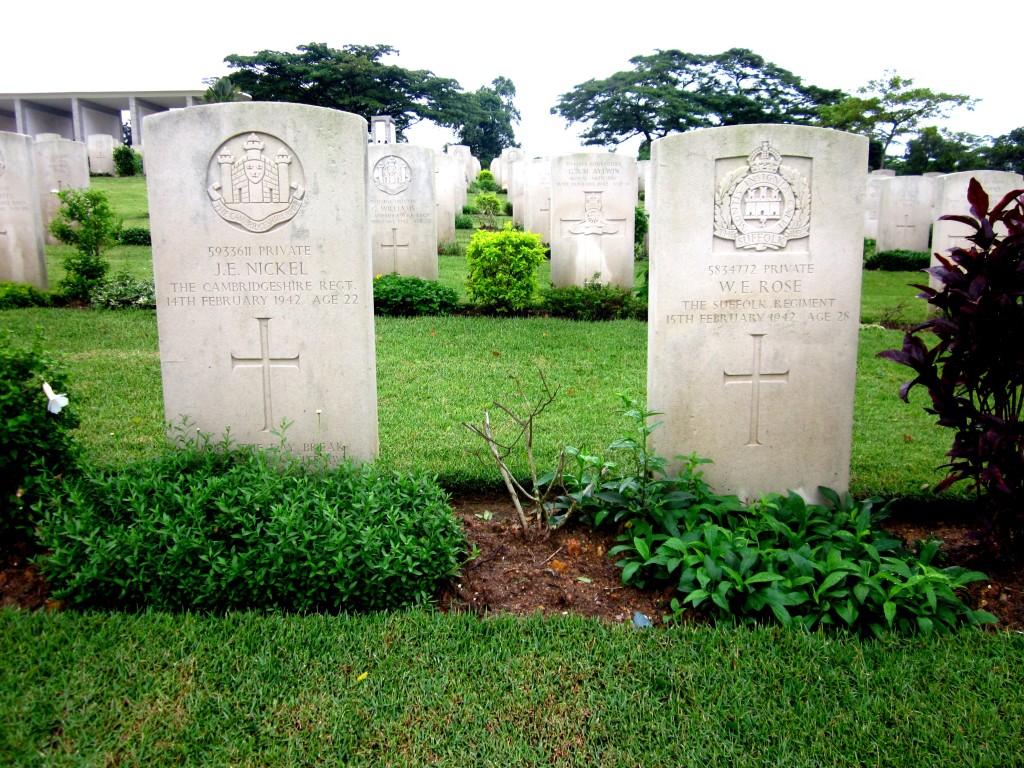
Kranji War Memorial Sunday 10 November, 2013. Cambridgeshire and Suffolk regiments (photo Mok My Yng)
From Jon Cooper. historian and war archeologist on the Adam Park Project, who also conducts the Battlefield Tour at Cemetery Hill once at month at Bukit Brown:
‘The fate of the missing Suffolks on Bukit Brown is just part of the rich WW2 heritage that can be found on the hills. There were many other units fighting in the area, constantly passing over the cemetery during the ebb and flow of warfare. It is most likely that there are more missing men to be found amongst the headstones.
There will also undoubtedly be spent ammunition and equipment to be found across the site, the remnants of fieldworks and bomb craters and the general detritus of war. Each item will be the part of a big jigsaw of artifacts and by plotting the locations in the landscape it will be possible to gather invaluable information about fighting that took place there.
The impending work on the hills will peel back the top layers and will undoubtedly expose these traces of the past.Hopefully the construction teams, with proper instruction will identify these clues and call in the experts to catalog and retrieve the material before the concrete is poured over it. There is a chance; just one chance to collect this invaluable evidence.
But most of all there is the possibility that we may come across the remains of our missing men. A chance to identify them and lay them to peaceful rest amongst their own. The fact that we go to great lengths to retrieve these men says as much perhaps about the attitude of Singaporeans today as it does about their generation of sacrifice.’
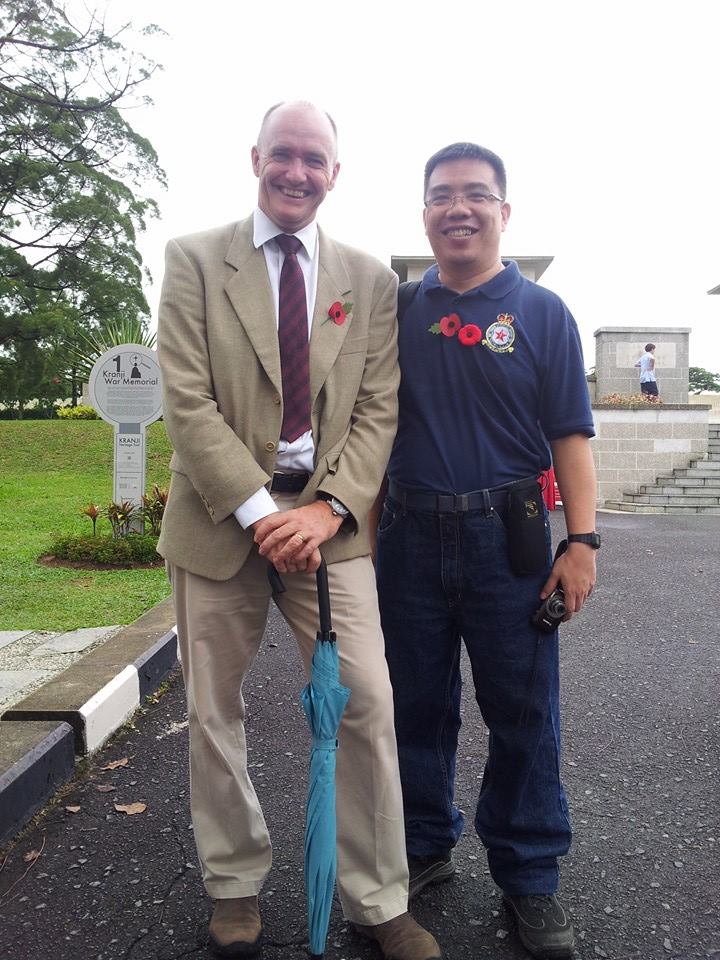
Jon Cooper and Mok Ly Yng who are working together to identify locations of the fallen Suffolk soldiers (photo Khoo Ee Hoon)

Mok Ly Yng at the memorial wall looking for the names of the fallen in the Battle on Cemetery Hill ( photo Khoo Ee Hoon)

The Suffolk Regiment casualties list on the Singapore Memorial at the Kranji War Memorial, columns 53 & 54. (photo Mok Ly Yng)
Mok Ly Yng is part of the documentation team tasked by the government to record and document graves affected by the impending highway
The Kranji War Memorial is dedicated to the men and women from United Kingdom, Australia, Canada, Sri Lanka, India, Malaya, the Netherlands and New Zealand who died defending Singapore and Malaya against the invading Japanese forces during World War II, it comprises the War Graves, the Memorial Walls, the State Cemetery, and the Military Graves.

Kranji War Memorial, Sunday 10 November 2013. A member of the Royal Air Force, which is Jon Cooper’s unit (photo Mok Ly Yng)
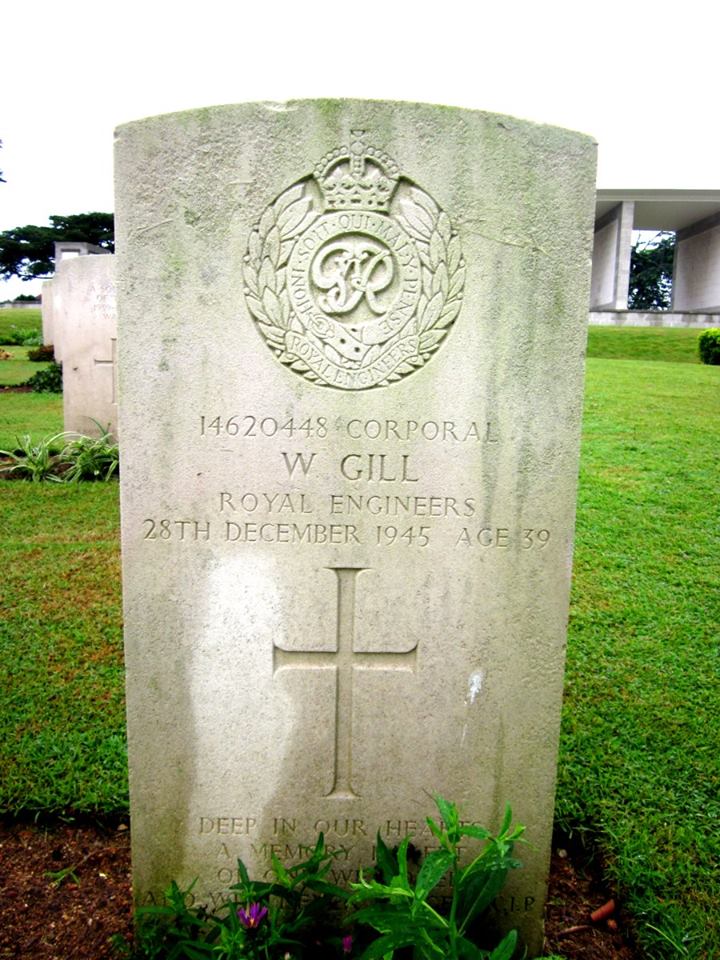
Kranji War Memorial, Sunday 10, November 2013. A member of the Royal Engineers, the unit responsible for mapping and map production (photo Mok Ly Yng)
Ubique Quo Fas Et Gloria Ducunt
Everywhere – Where Right and Glory Lead
The Case for a Bukit Brown (National) Heritage Park
by Chew Kheng Chuan
7 November, 2013.
Sometime ago when I was looking at Google Earth to check out Bukit Brown, I was struck by what a huge green lung it was that was contiguous to the main Water Catchment Area of MacRitchie and Pierce Reservoirs. In that sense the greenery was part of a single “critical mass,” whose significance – ecological and environmental – depended critically on its mass to create the climatic and rainfall needs of Singapore. I felt that taking away this greenery would be a major detraction and subtraction that cannot be replaced by the addition of many other smaller parcels that may add up to the same area if aggregated.
Otherwise I am very sympathetic to the pressures of the planners needing to look to the provision of housing and road requirements of a developing city and nation.
However I feel it is highly regrettable that Bukit Brown Cemetery has to be sacrificed on the altar of development. It will be an irretrievable loss. This is a resting place of the pioneers of our nation and is a cultural and historical heritage that is the physical expression of our sense of origins and identity.
Are there alternatives? This is a serious question that must be considered further and deeper. When Bukit Brown is developed into a future residential estate, the beneficiaries are limited to the fortunate people who will live there, next to the greenery of MacRitchie Reservoir. However it will be lost to the larger public.
Yet if Bukit Brown were to be gazetted as a National Heritage Cemetery Park, and developed as such, keeping all the graves which represent the earliest of burials in Singapore, and are an authentic expression of the anthropological rituals, ceremonies and culture of a people (still alive and active annually every Cheng Beng period), it can benefit all residents of Singapore, and into the future. Let me explain why.
Indeed the National Parks Board can look to developing this into a National Heritage Cemetery Park (or should that be the Bukit Brown Heritage Cemetery National Park?), develop the landscape and plantings, preserving the old trees, and grow new flora. Then it becomes a NEW environmental, recreational, cultural, historical, educational, natural, and yes, economical-tourism resource for all residents in Singapore – citizens, PRs, migrant workers, visitors, tourists, students, nature lovers, birdwatchers, filial descendents who observe the rites and rituals of Cheng Beng
It then becomes a public space rather than a private, historical, forgotten, “under-utilised” cemetery. Perhaps a stronger case can be made that this serves more powerfully the larger public good than the limited number of the lucky few future residents of the new residential estate of Bukit Brown?
An MRT has been planned and will be built for Bukit Brown – indeed, that will not detract from nor be wasted by the new identity and purpose of this National Heritage Park, for all of Singapore will need good transportation access to it to enjoy its benefits. The Bukit Brown MRT in a new status of Bukit Brown will in the longer run better justify its location and existence, bringing a far greater number of commuters to it than that planned for just residents of the area were it to be an exclusive residential district.
I would argue for considering such an alternative future for Bukit Brown to preserve its past of pioneer burials, and enhance its future, even if my ancestors were not buried there. Indeed, as a child I used to accompany my father and relatives every Cheng Beng, but with their passing I have discontinued this ritual for many decades, which explains why my children have never visited the grave of their great-great-grandfather Chew Boon Lay until recently
I asked my children what thoughts they might wish to share. They said:
“Our father told us we are 5th generation Singaporeans, which we think is cool. We wonder how many of our friends have been in Singapore for 5 generations? Our great great grandfather Chew Boon Lay and great grandfather Chew Hock Seng, are both buried at Bukit Brown. We’re kinda sad that when the cemetery is gone they will be just a memory and lost in our future.”
Chew Kheng Chuan is the great grandson of Chew Boon Lay.
This is a blog post that will be updated as the destruction continues……
Thursday 28 November ( Pre Exhumation Rituals) : The Roundabout has become a road
A reminder of what it once was, almost exactly a year back in December 2012 :
Friday 22 November
Wednesday 13 November , roundabout paved
Saturday, 9 November. Morning 9am, no works within the grounds.
Guided walks proceeded from the ‘ole rain tree. Respite!
Thursday, 7th November. The road works in progress
Paving the roundabout, and putting up hoardings along Adam Road.
Photos on Flicker on 7th November, 6pm here
Wednesday 6th November, other areas barricaded by concrete blocks
Wednesday 6th November, 2013 clearing continues at the roundabout
Tuesday 5th November, 2013. The roundabout is destroyed.
Friday, 11 October, 2013. The roundabout is barricaded and sealed
Before Oct 11, 2013. The Roundabout
Today, Tuesday 5th November, 2013, the roundabout at Bukit Brown was destroyed.
“Now a black bird wings across.
The low sky saw it open its beak. No sound comes.
What were we destroying?”
Too many pausing to question the dusk,
glorious colours drain within their eyes,
forgetting questions it stirred.”
— Chew Kheng Chuan, 1977
“A sense of history is what provides the links to hold together a people who came from the four corners of the earth. Because our history is short and because what is worth preserving from the past are not all that plentiful, we should try to save what is worthwhile from the past from the vandalism of the speculator and the developer, from a government and a bureaucracy which believes that anything that cannot be translated into cold cash is not worth investing in.”
S Rajaratnam, “The Uses and the Abuses of the Past”, Seminar on Adaptive Re-use: Integrating Traditional Areas into the Modern |
Urban Fabric, (Singapore, April 1984)
We made our share of mistakes in Singapore. For example in our rush to rebuild Singapore, we have knocked down many old and quaint Singapore buildings. Then we realized we were destroying a valuable part of our cultural heritage that we were demolishing what tourists found attractive and unique in Singapore. We halted the demolition. Instead, we undertook extensive conservation and restoration of ethnic districts such as Chinatown, Little India and Kampong Glam and of the civic district, with its colonial era buildings: the Empress Place, old British Secretariat, Parliament House, the Supreme Court, the City Hall, the Anglican Cathedral, and the Singapore Cricket Club.
The values of these areas in architectural, cultural and tourism terms cannot be quantified only in dollars and cents.
We were a little late, but fortunately we have retained enough of our history to remind ourselves and tourists of our past. We also set out to support these attractions by offering services of the highest standard.
Lee Kuan Yew, 13 March 1995
Kwong Tong Cemetery Kuala Lumpur
by Simone Lee
4 November, 2013
The Kwong Tong Cemetery is the oldest cemetery in Kuala Lumpur, covering 343 acres of land. It is the final resting place of many prominent city pioneers including Yap Ah Loy, the founder of Kuala Lumpur. In 2007, the 112-year-old cemetery – a green lung in the city – was named a Heritage Park.
My great grandparents are buried in Kwong Tong Cemetery and in October this year I visited them for the second time in 20 years. I can barely remember my first visit as a child. The visit was a result of a confluence of events, the catalyst : Bukit Brown. I first visited Bukit Brown in July, a week after the death of my father. In the weeks that followed I joined the Brownies regularly on their guided walks. I was moved by the stories they told of the pioneers buried there and their contributions. On October 5th, after I conducted my first guided walk “Stories of Ladies in the Straits Settlements”, I felt I was ready to trace the path of my roots.
Even as I embarked on the journey , I was helped by a fellow Brownie, Jonathan Siew who introduced me to his friend Boon Hin who knew Kwong Tong Cemetery well. He drove my mother and I around the cemetery. Naturally, our first stop was at my great grandparents’ tomb .
My Great grandparents Graves
Just like many other sinkehs (new comers, fresh from the boat from China) at that time, my great grandfather, 利曉春(1888-1962) and his wife arrived from Meixian, Guangdong in the 1930’s. He was a tailor but soon went into tin mining, a thriving commodity in Kuala Lumpur at that time. He was successful and brought my grandfather over to help him in the tin-mining business. The entire family (3 generations; great grandparents, grandparents’ siblings and their children) lived in a large British colonial villa at Bukit Bintang (which was later torn down to build shopping malls).
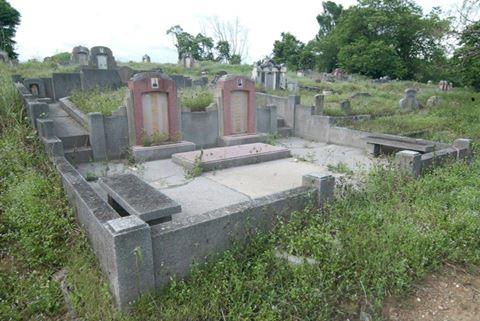
Kwang Tong: The graves of 利曉春(1888-1962) and his wife, Simone’s great grandparents (photo Simone Lee)
Mah Kan Poh
My great grandparent’s neighbour is Mah Kan Poh
The epitaph on the late Mah Kan Poh’s tombstone erected by his descendants.
“Born on the 14th day of the 12th Moon of Thung Chee Yam Shutt Year, or the 1st of February 1863; and Died on the 29th of May, 1938, or the 1st of 5th Moon, Mo Yen Year – at the age of 77 years. The late Mr.Mah Kan Poh was a native of Yong Kow village, Soon Tuck District – in the province of Canton. He was very thrifty and hardworking, and took to silk trading as his first walk of life. At the age of 26 years, he came over to Malaya. He was first interested in tin-mining and then – revenue farms. Later on he took to rubber planting and he could walk for miles daily in his estate and mines. One of his favourite hobbies was hunting. On many occasions, we advised him to give this up, but he turned a deaf ear to our counsel. In summing up, we might say that the deceased was a man of great courage and determination, and that we and our descendants should follow his footsteps as best we could.”
The Nanyang Volunteers Memorial erected in 1947
When the Sino Japanese War erupted on 7 July 1937, the Chinese government’s logistic concern was security of supply routes importing war materials into China. This led to the construction of the Burma Road linking Kunming with Yangon port in British Burma. The Chinese government also realized the lack of skilled drivers and mechanics in China. To solve this problem, they turned to China Relief Fund headed by Mr Tan Kah Kee to recruit drivers and mechanics from all over Nanyang, today’s South East Asia. These drivers and mechanics are known as the Nanyang Volunteers, 南侨机工. From February to September 1939, 3200 Nanyang Volunteers left in 15 batches and most eventually served on the Burma Road. Most of the Nanyang Volunteers were Chinese man but there were also some Malay and Indian men and four Chinese women. Source
The Japanese War Memorial
This site marks a 10,000 square feet mass grave of the casualties during the Japanese occupation. Remains of close to a thousand victims were relocated from the original site, “Tomb of War Victims of the Compatriots of the Republic of China” which was in a dilapidated state.
The Butcher’s Guild Graves
Built in 1931, from the back, it’s a walk through concrete grids towards the front yard.

Kwong Tong:concrete grids of the graves of the Butcher’s Guild, view from the back (photo Simone Lee)
The Lim Lian Geok Memorial
Lim Lian Geok (1901-1985) was former Chairman of The United Chinese School Teachers’ Association Of Malaysia (popularly known as Jiao Zong), was a great educationalist as well as a famous social activist.
People from all over the country, put aside their works and came all the way to pay their last respects to him, including high-ranking leaders of political parties. A fund in memory of him was set up, which was later registered as LLG Cultural Development Centre, a non-profit organization. Source
Chua Cheng Tuan : The Cycle & Carriage Family
The Cycle & Carriage family: All except for the 2 tombs at extreme left and right (forefront) are in the Chua family gated plot. You can even see the fence surrounding the cluster behind the trees on the left of photo. At the centre of the plot is Mr.Chua Cheng Tuan, the founder of Cycle & Carriage. His brother Chua Cheng Hock is buried in Bukit Brown.
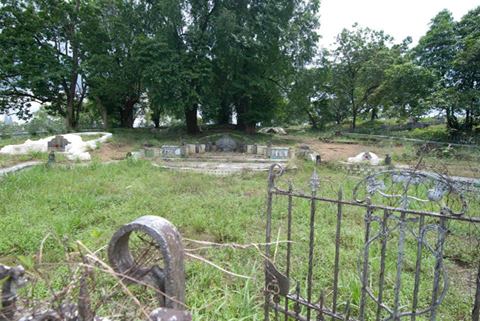
Kwong Tong : centre of the family cluster is plot of Mr.Chua Cheng Tuan, the founder of Cycle & Carriage (photo Simone Lee)
A pavilion was built by Chua Cheng Tuan’s family, in front of the family plot, in his memory. Today many other graves surround the pavilion.
Other interesting tombs at Kwong Tong Cemetery
This collective teochew tomb has a large mound and a tortoise supporting the tomb stone. Engravings of the Confucian story; 24 filial exemplars lines the arms of this large tomb.

Kwong Tong:panels with stories of the 24 filial piety exemplars on the “arms” on the Teochew tomb (photo Simone Lee)



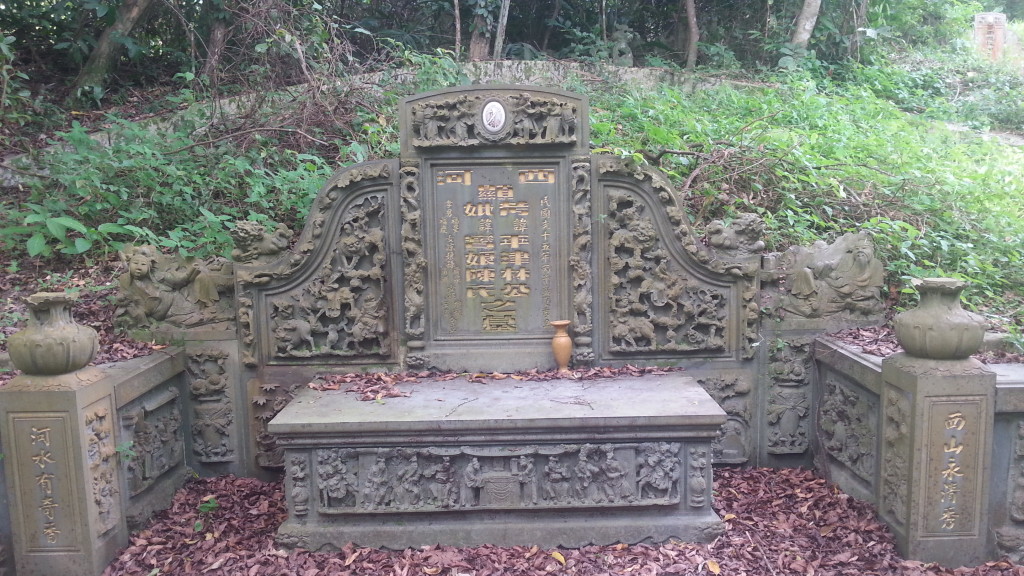

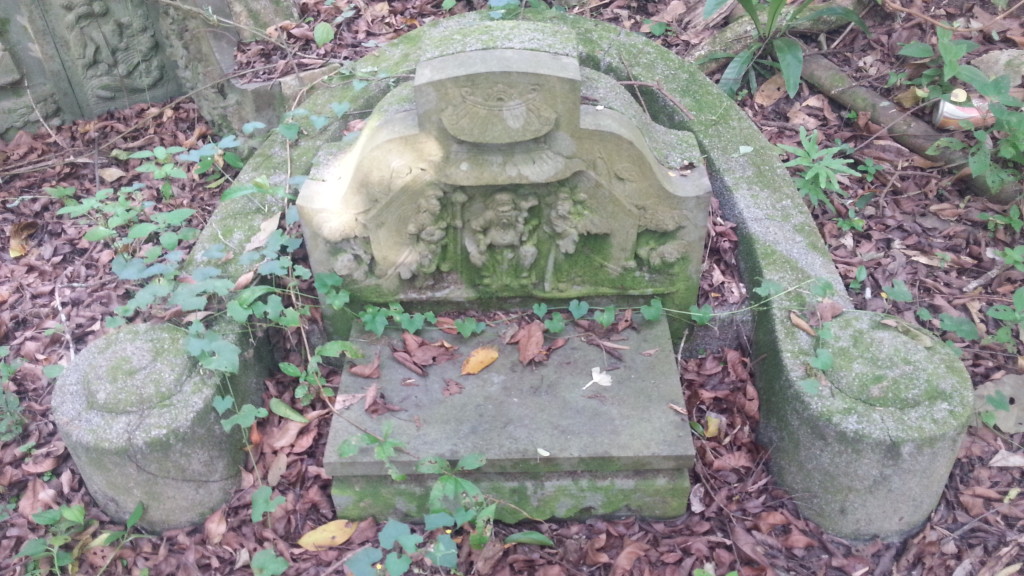

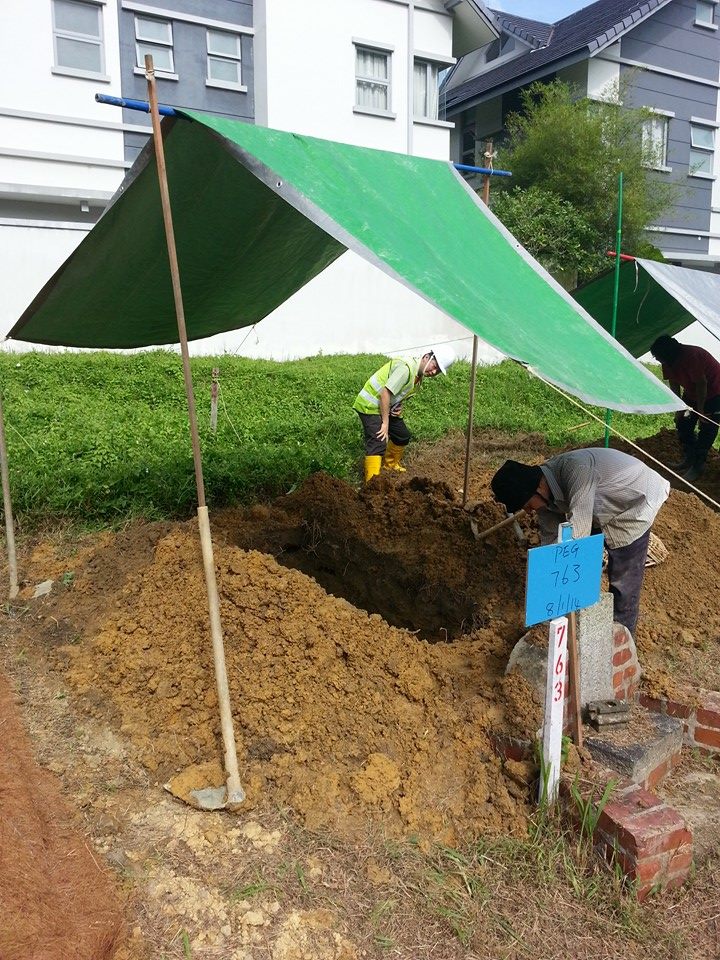
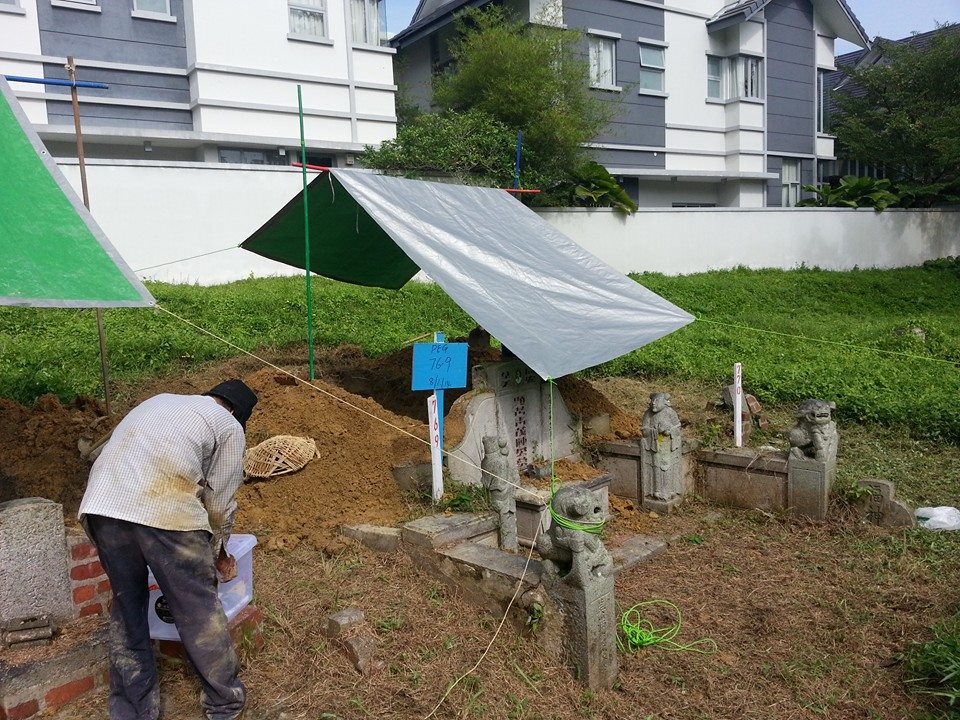

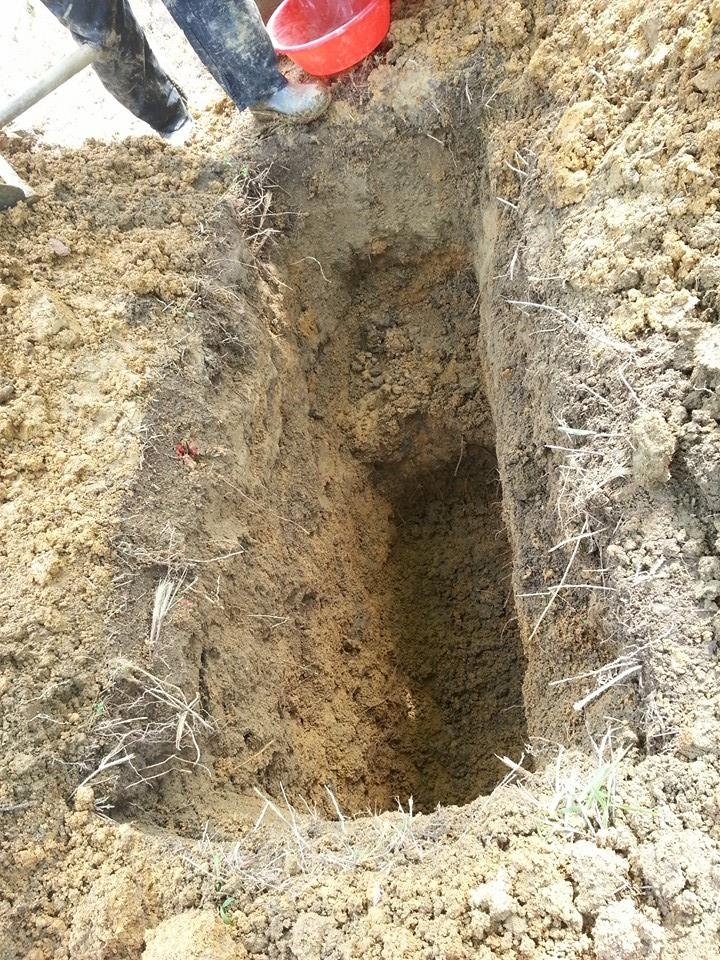
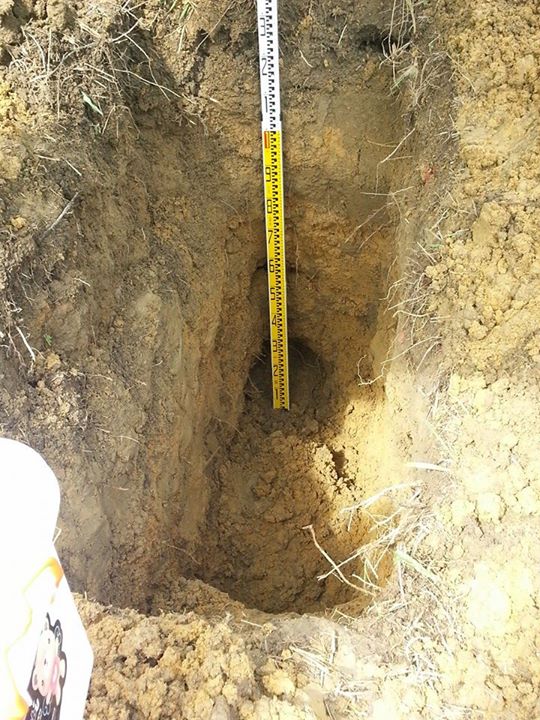

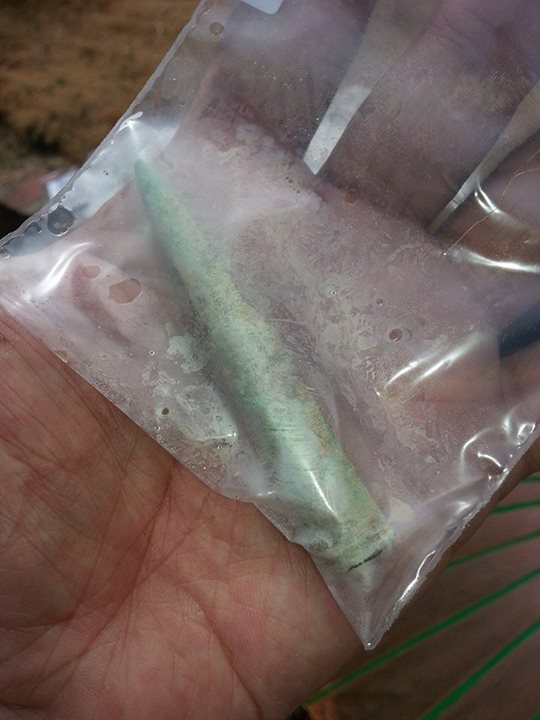
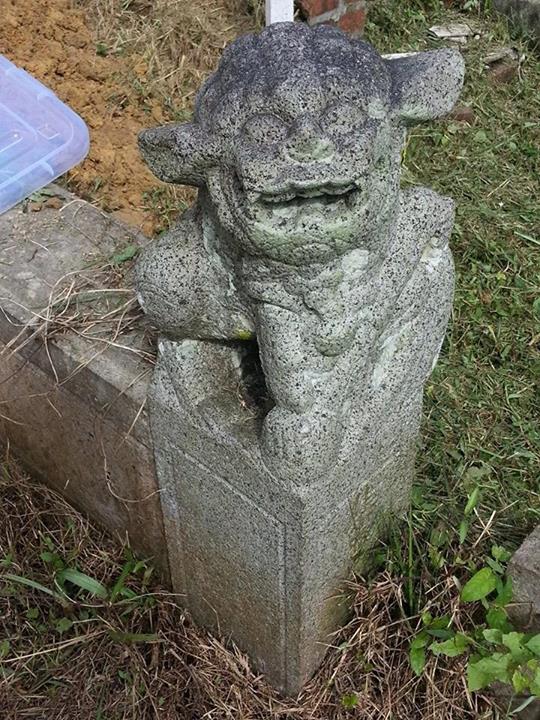
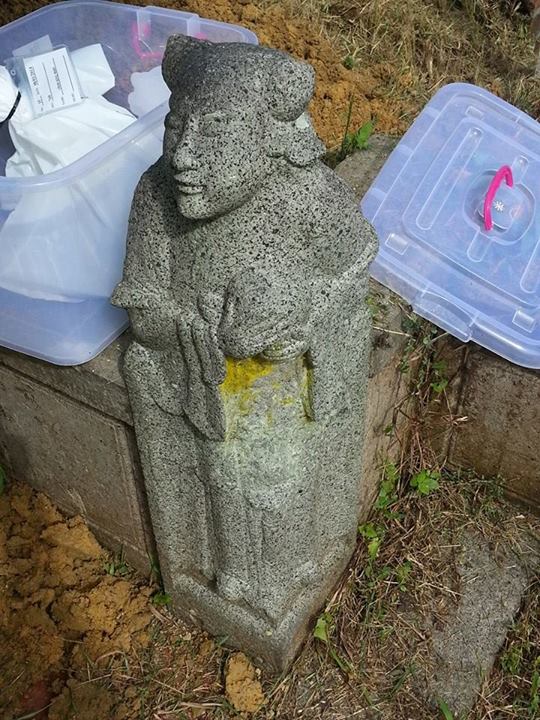
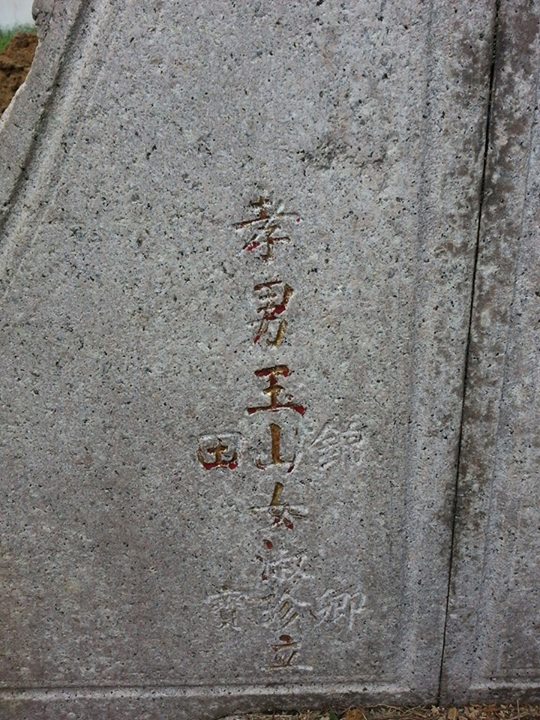

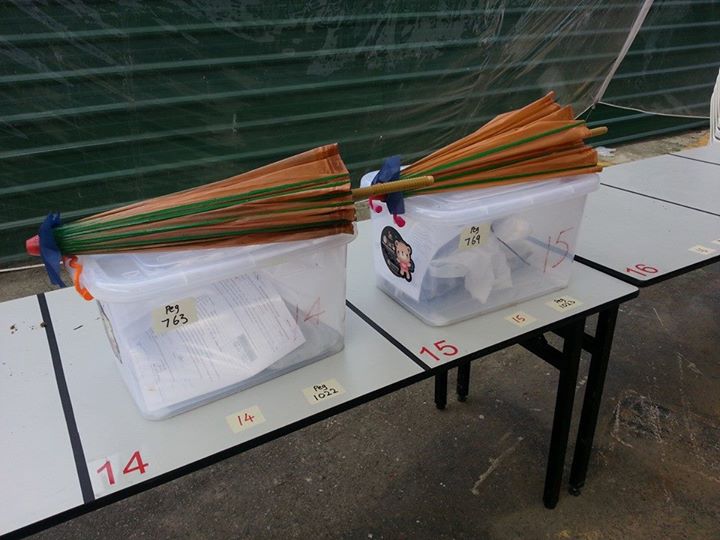
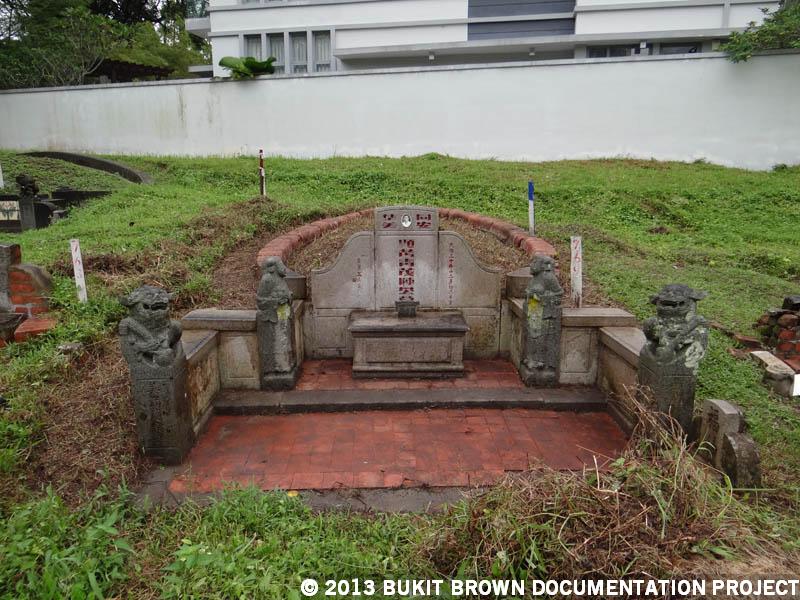
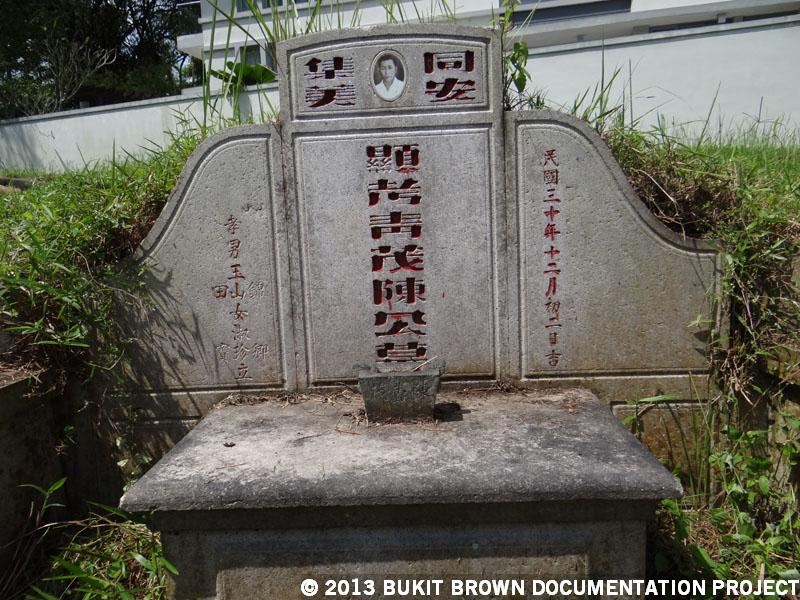
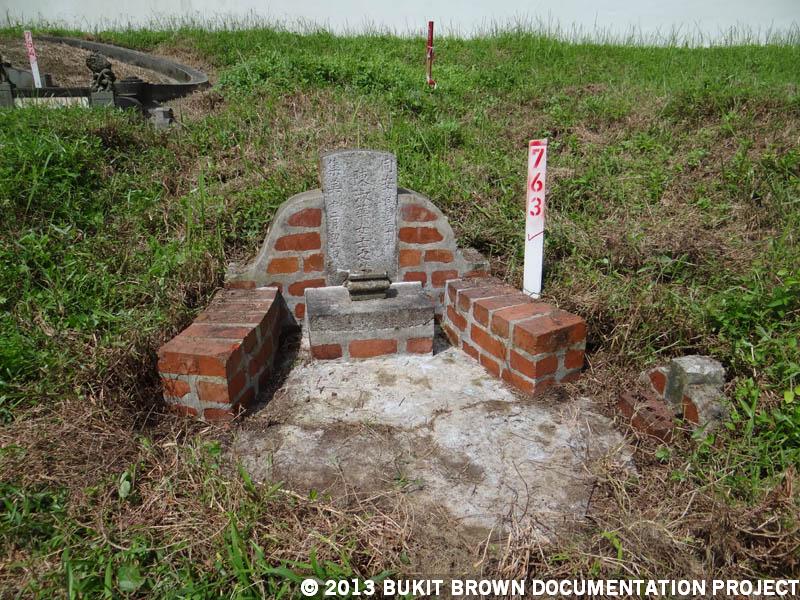

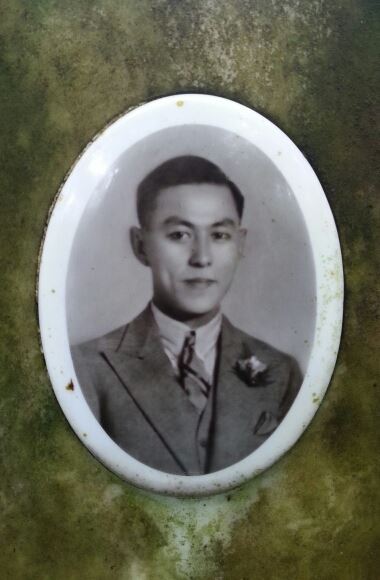
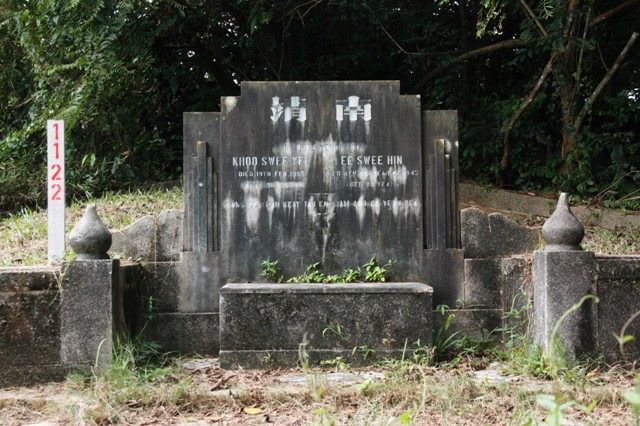
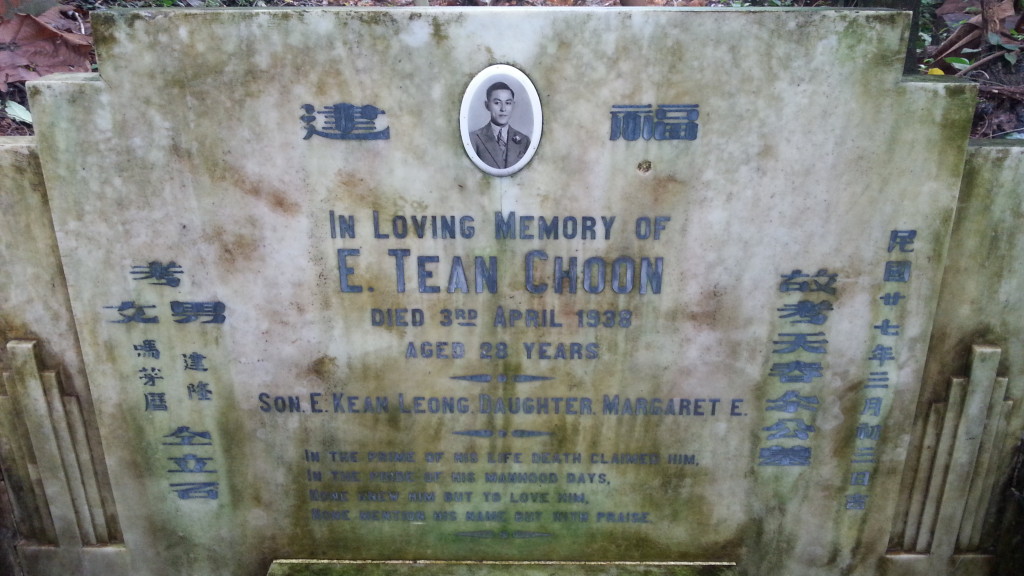
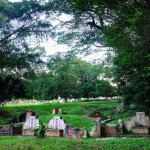


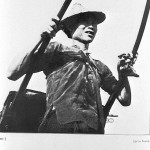

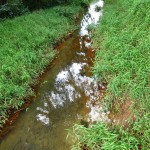




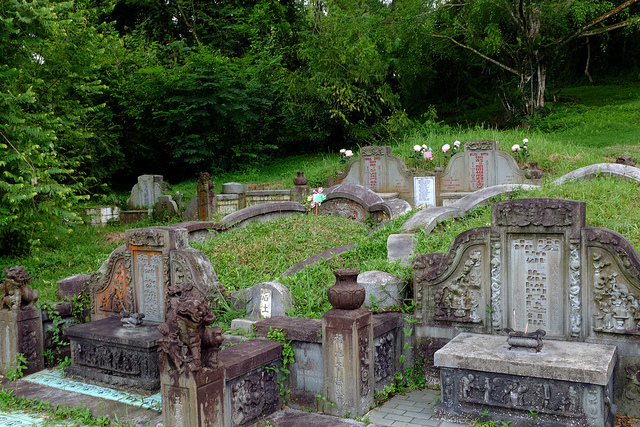
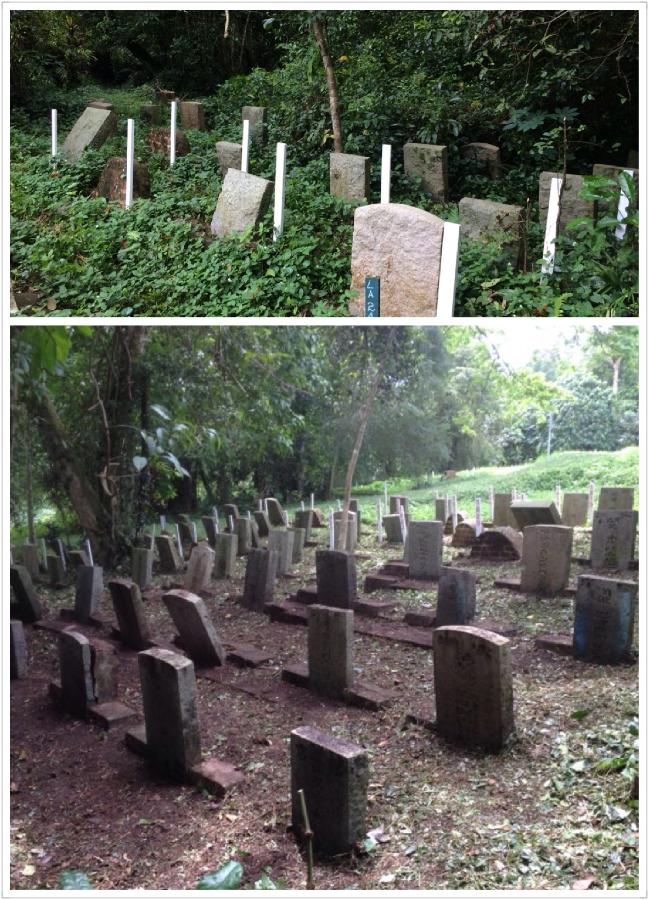

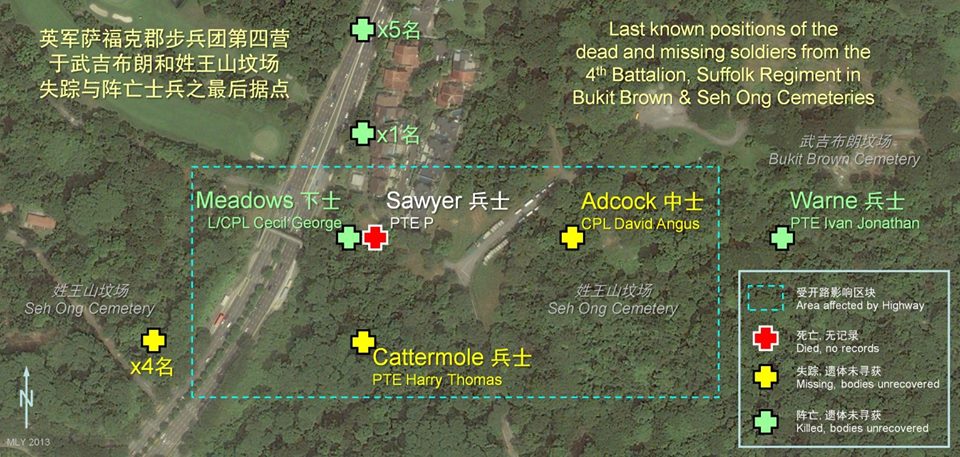
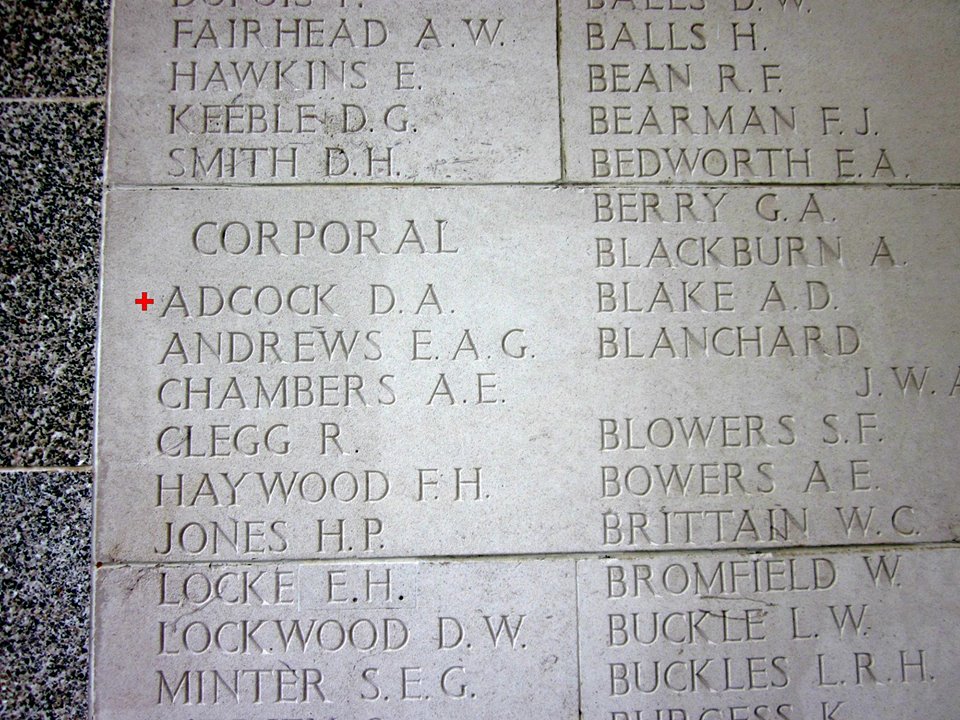
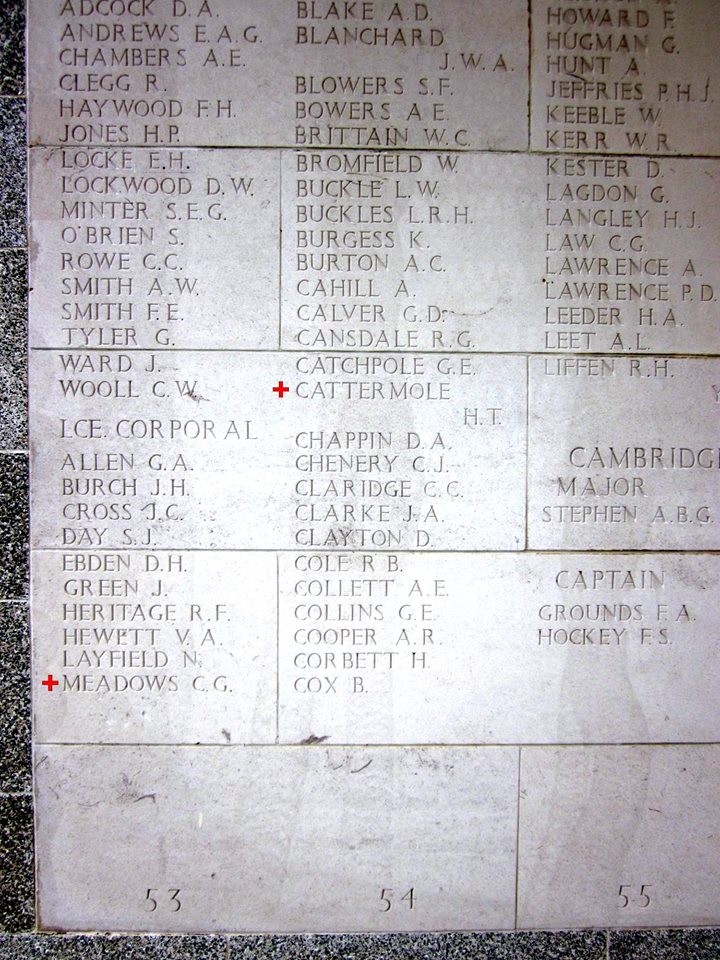
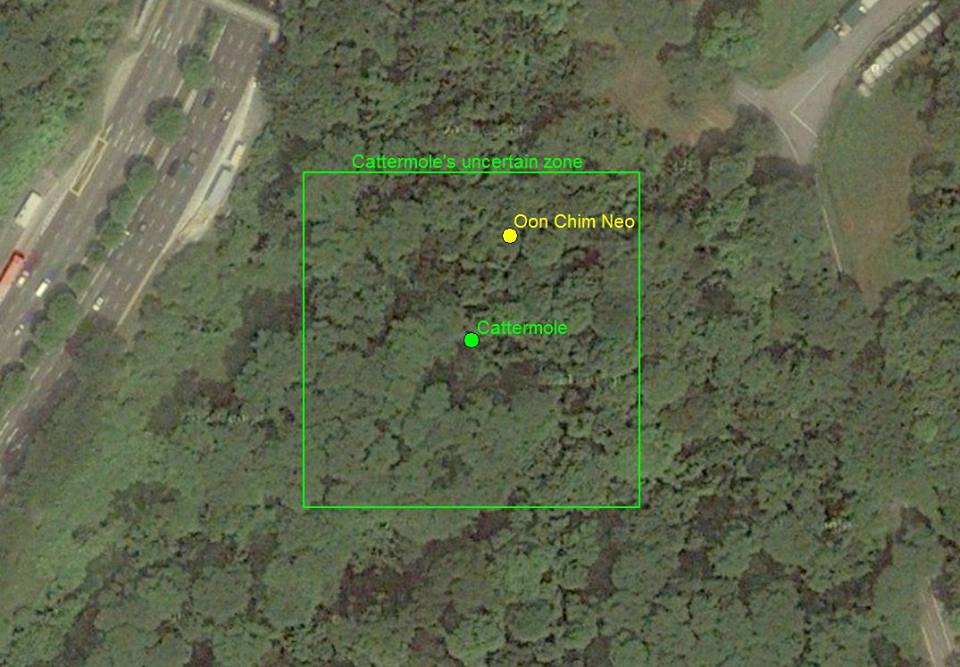
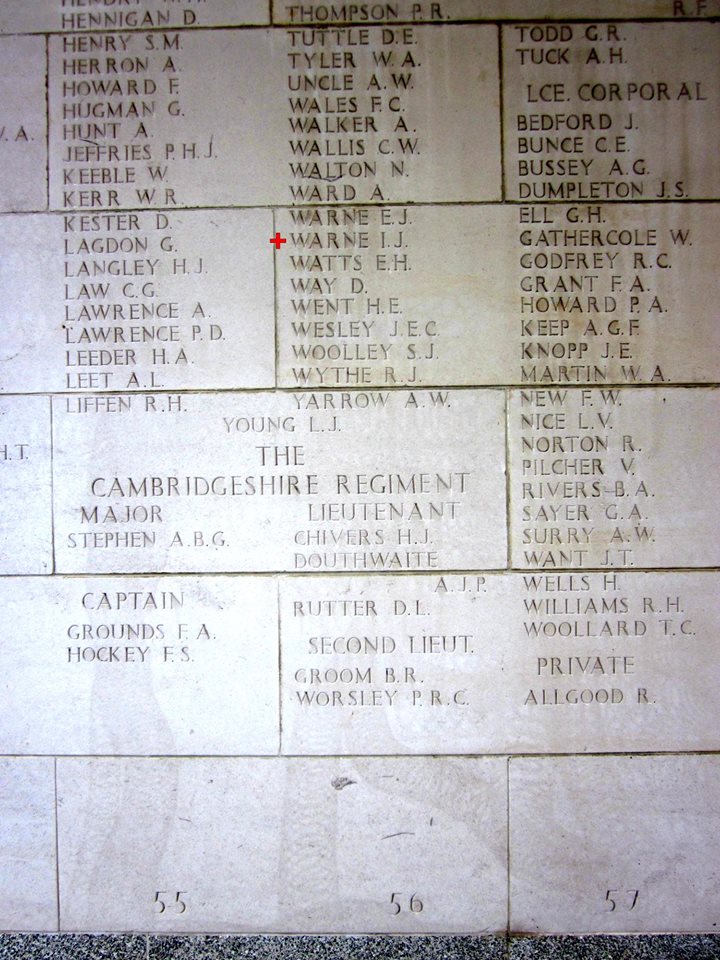
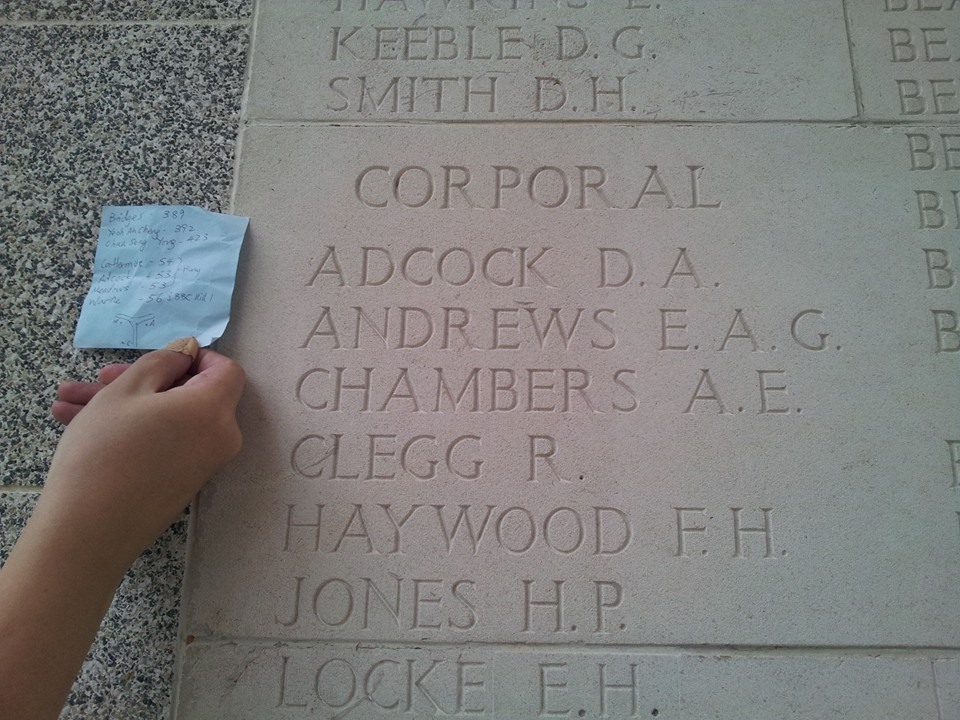

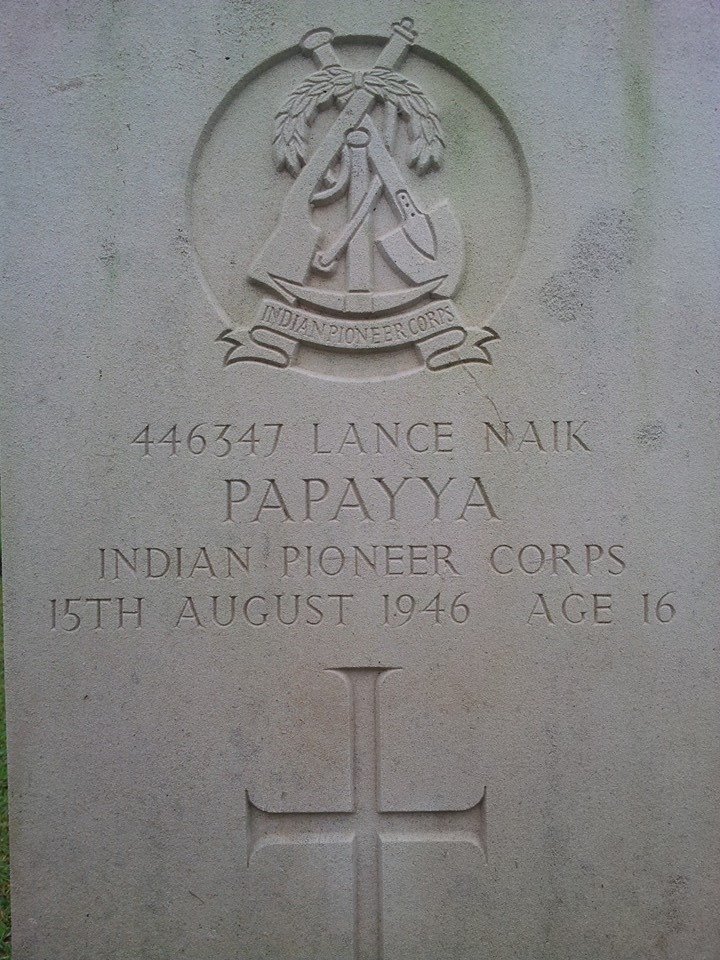
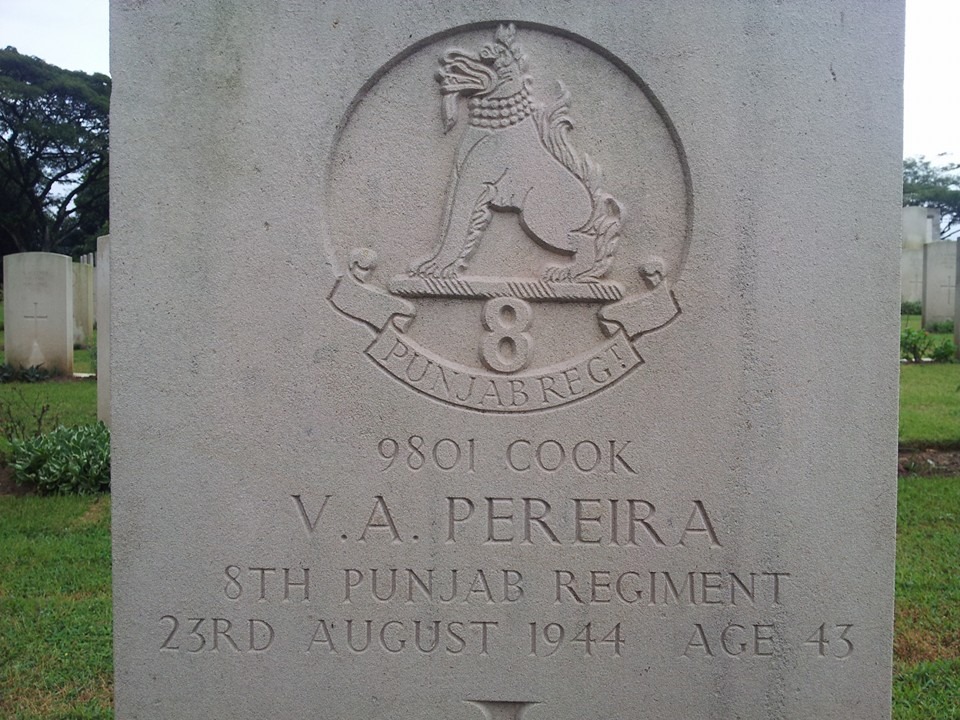
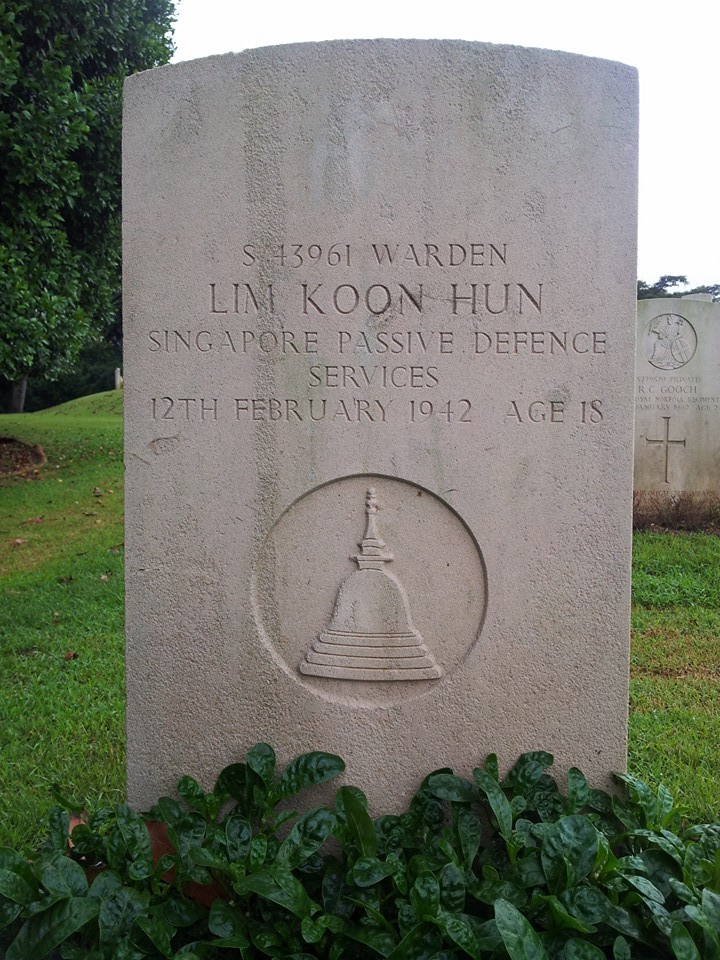



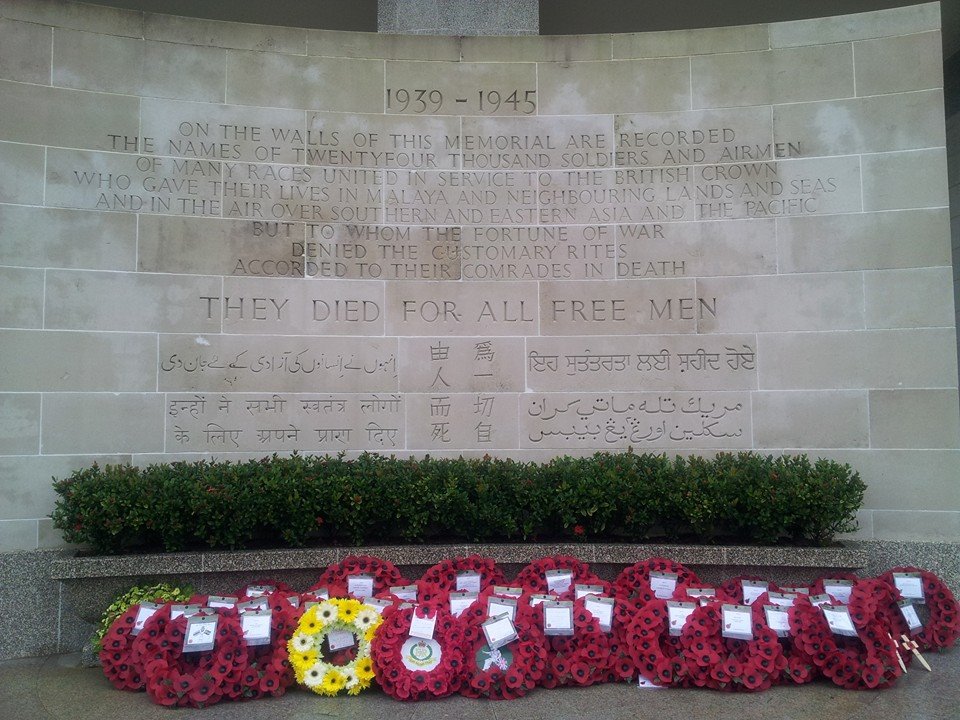
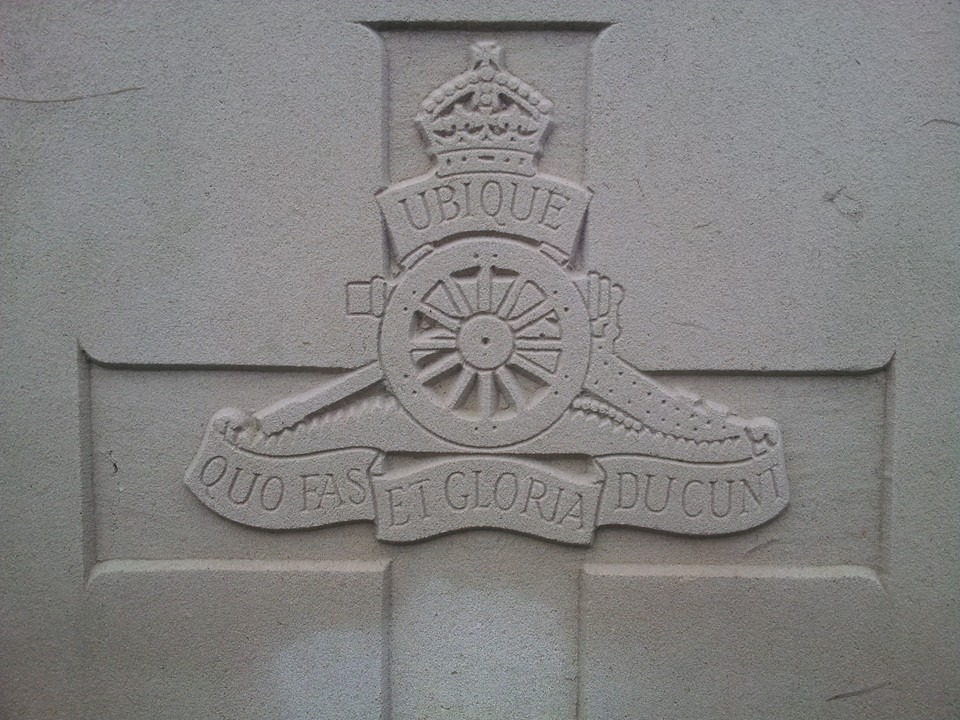
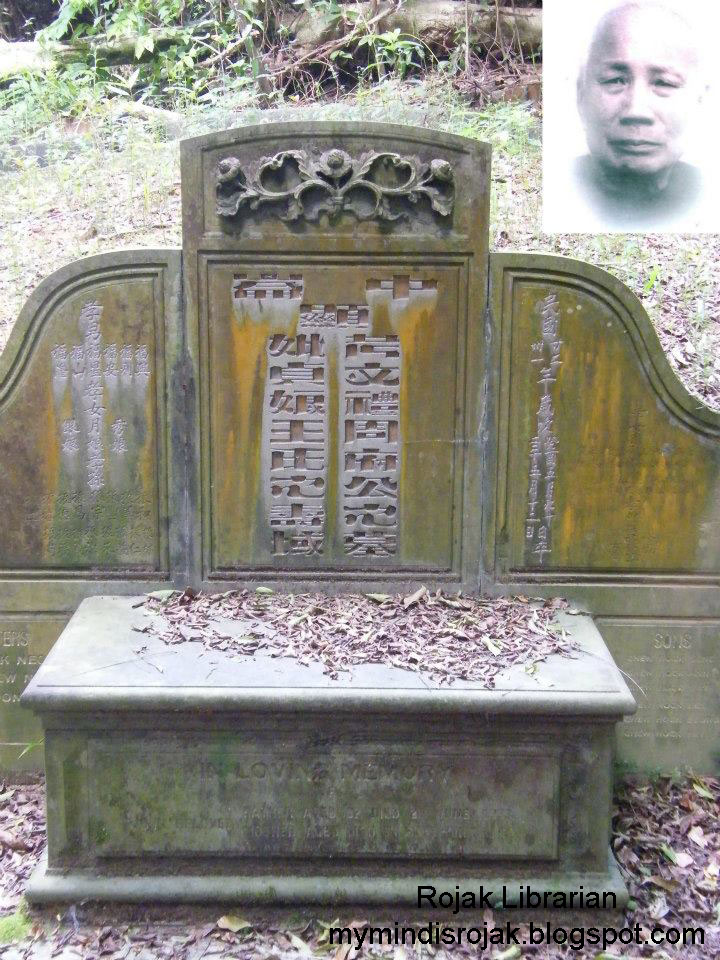
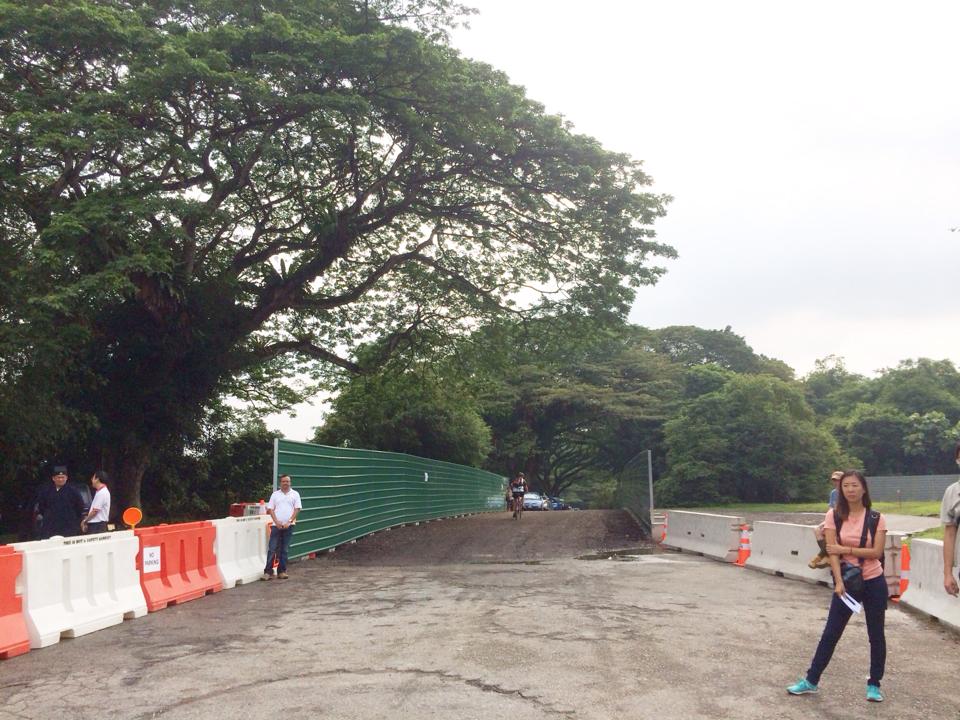

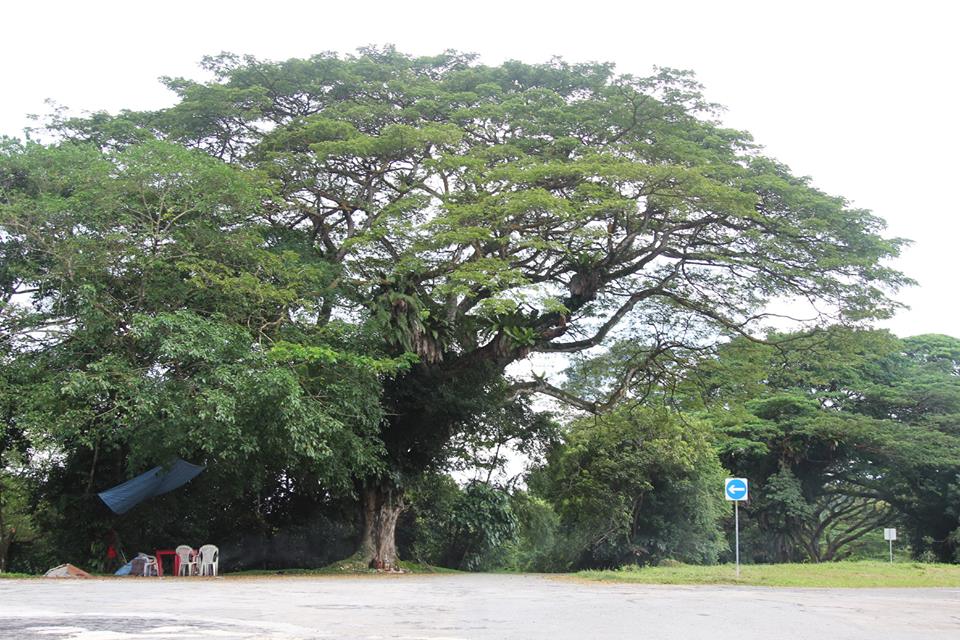

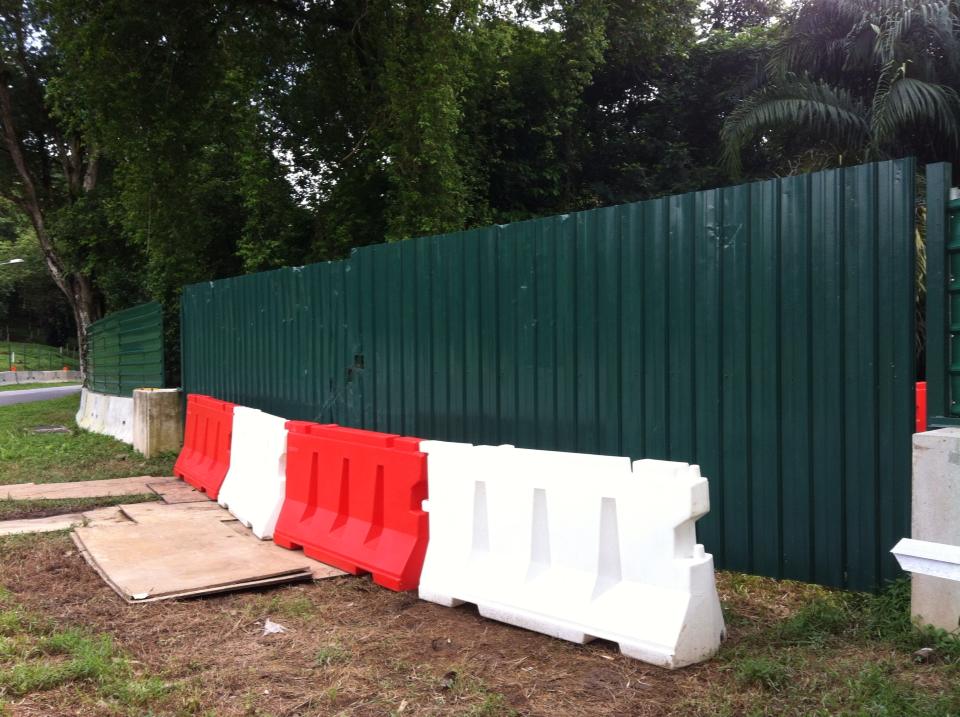
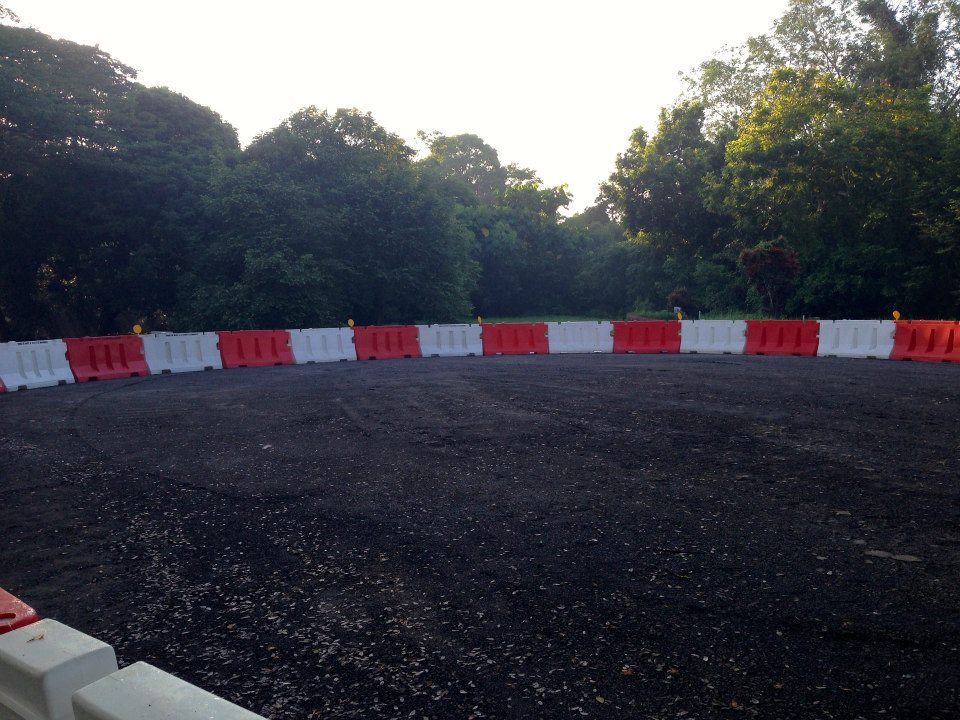
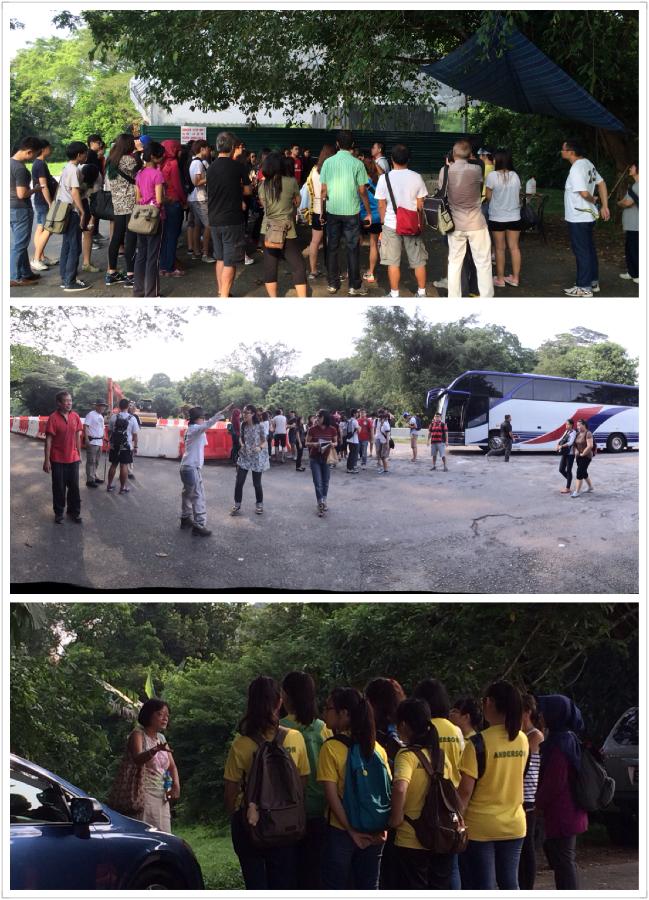
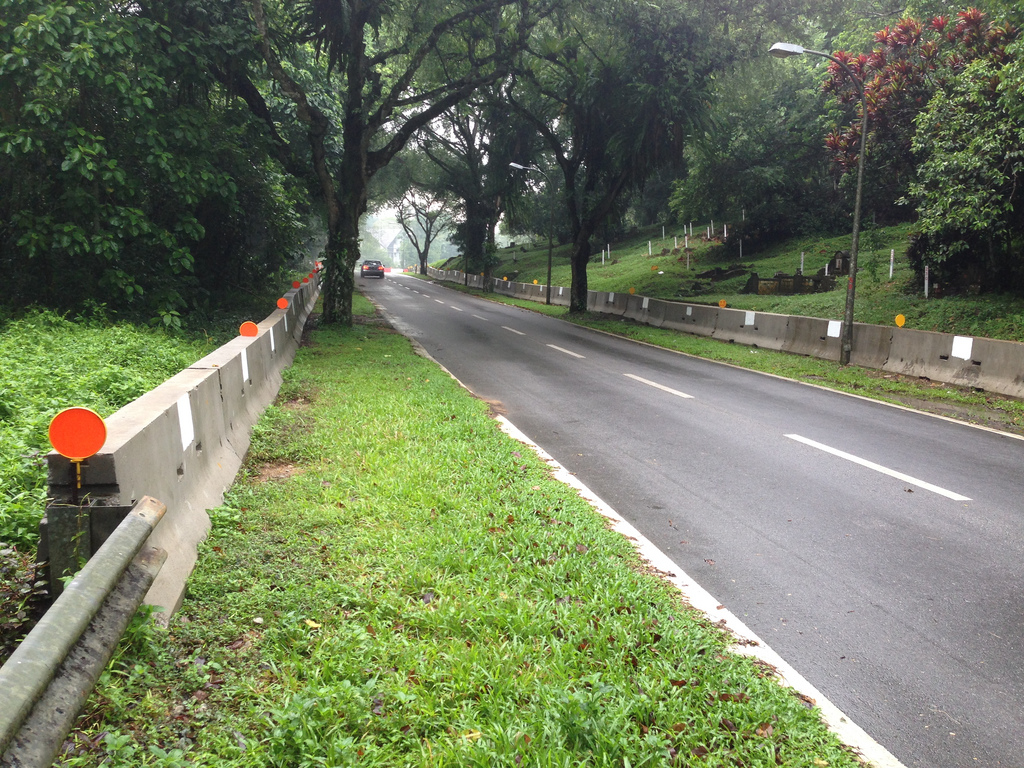
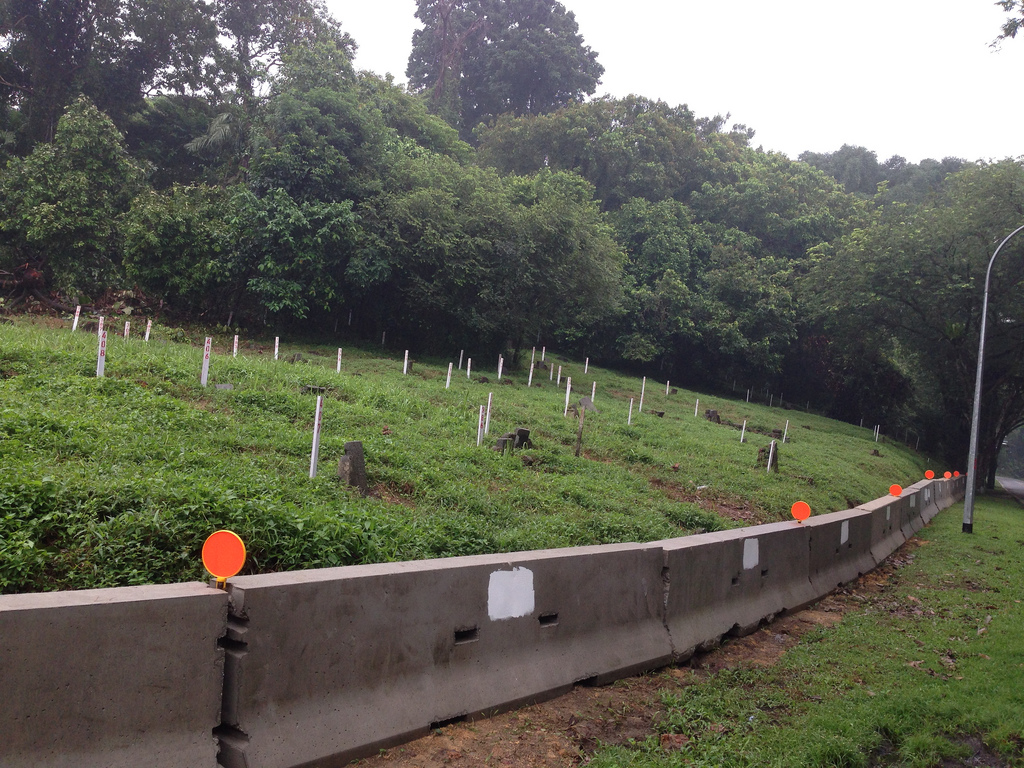
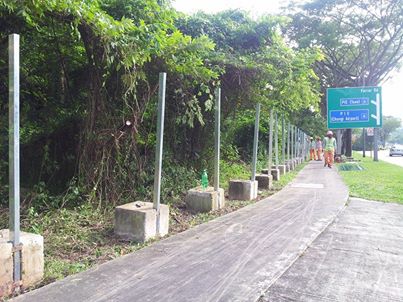


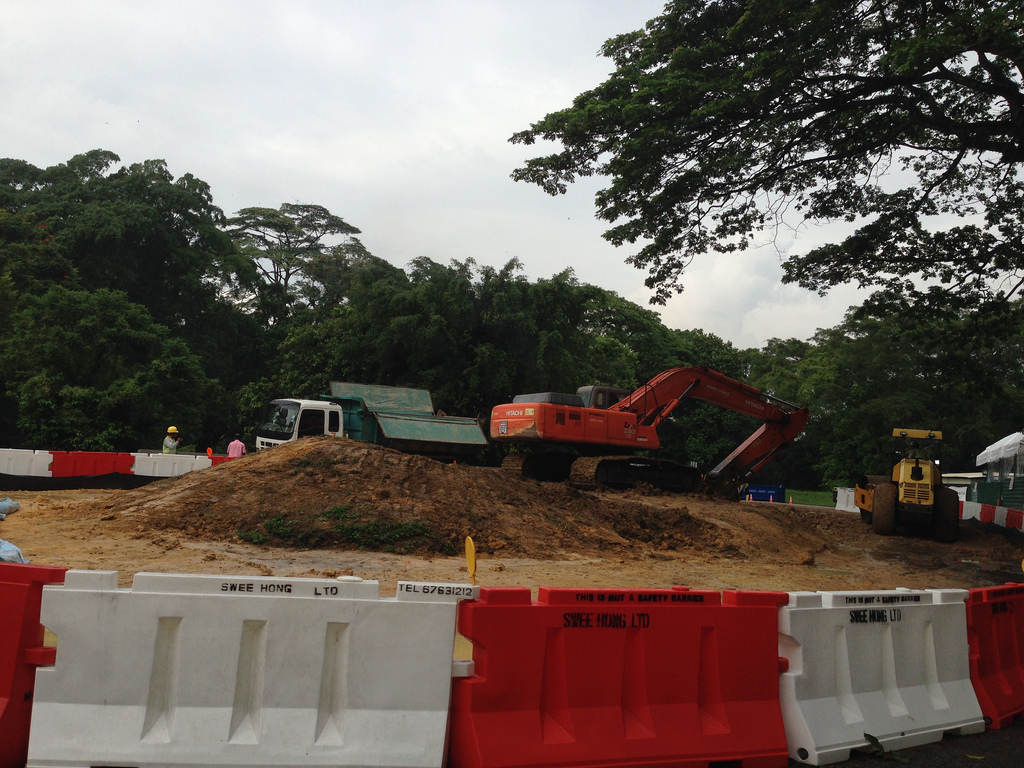
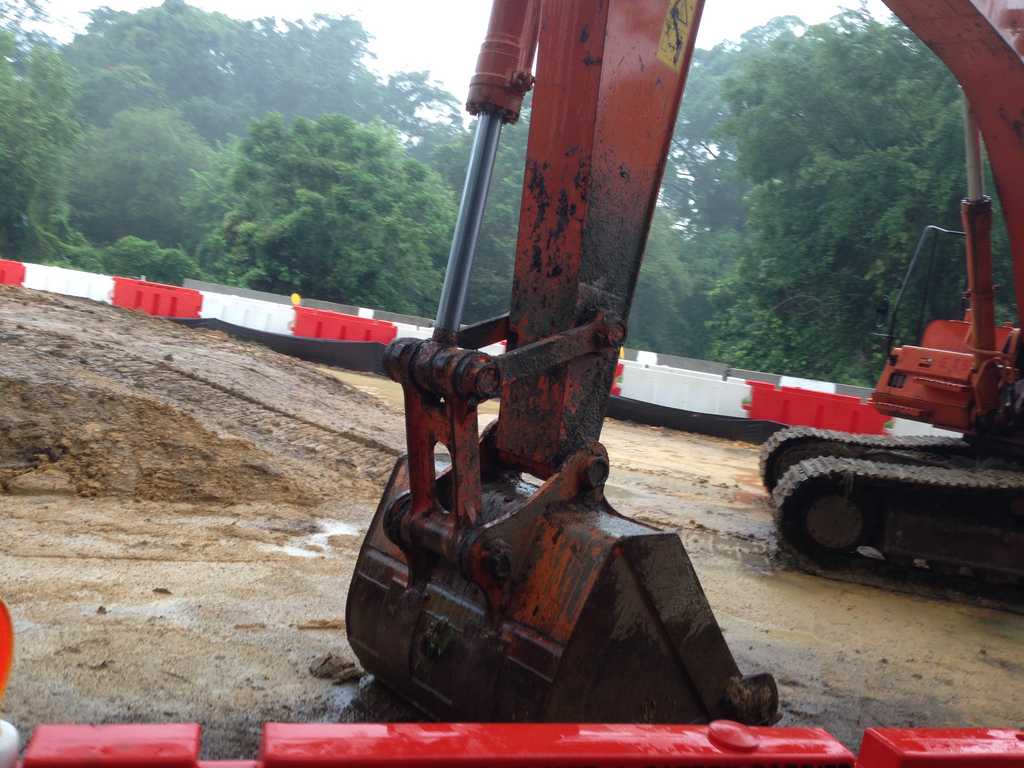
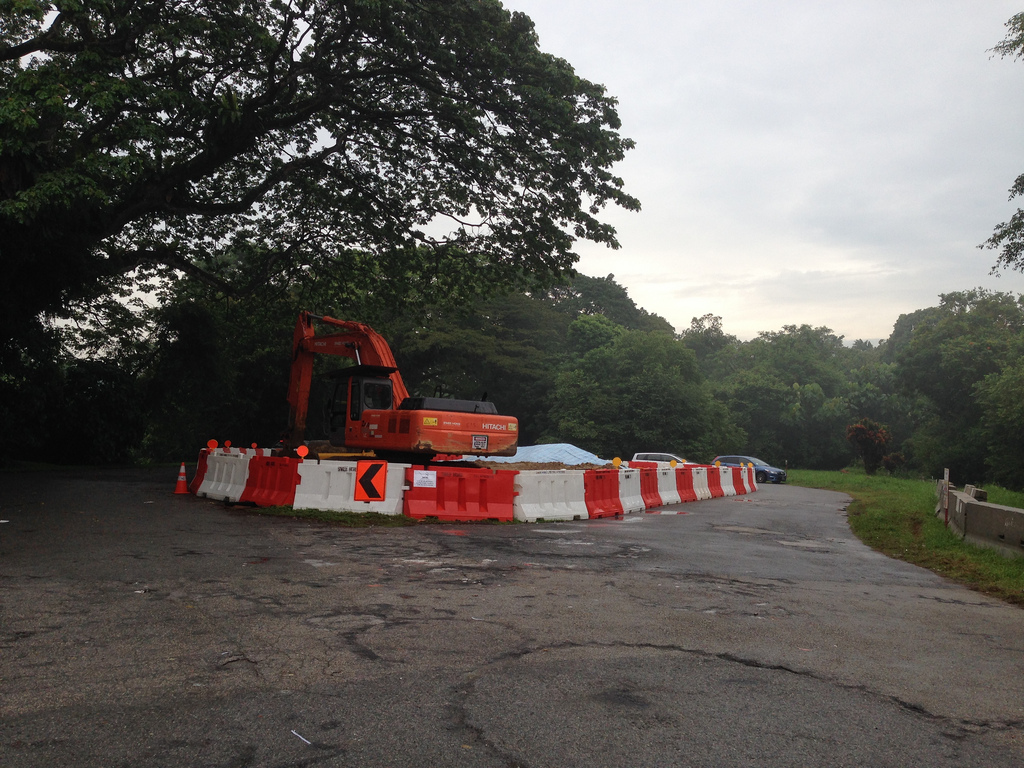
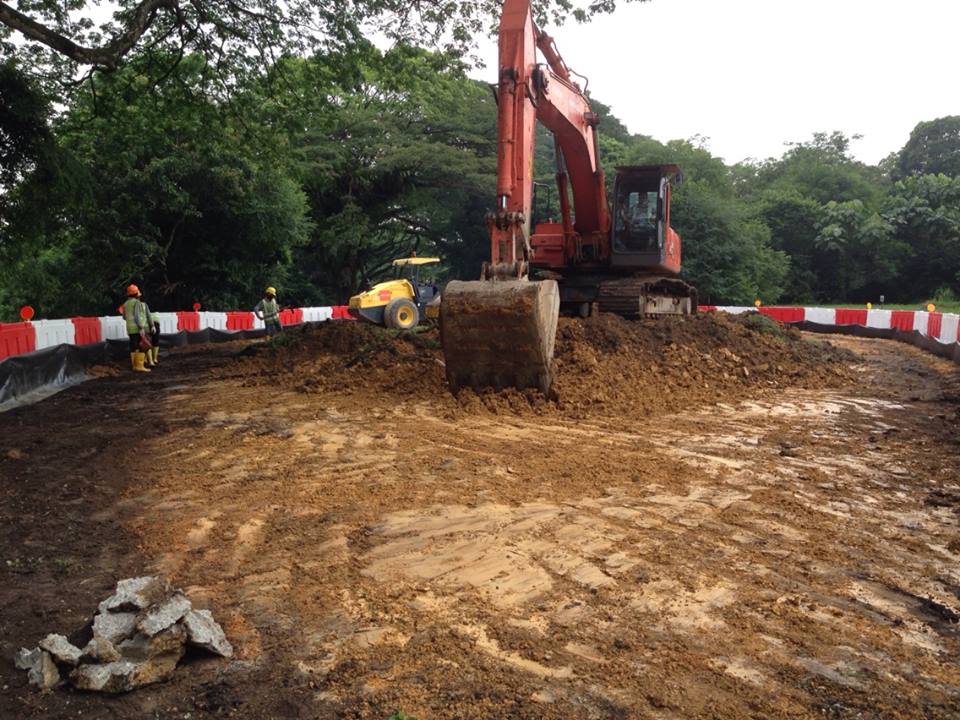
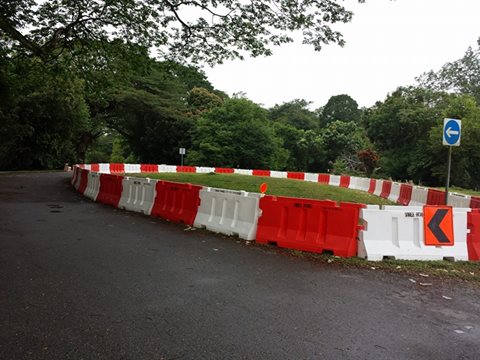

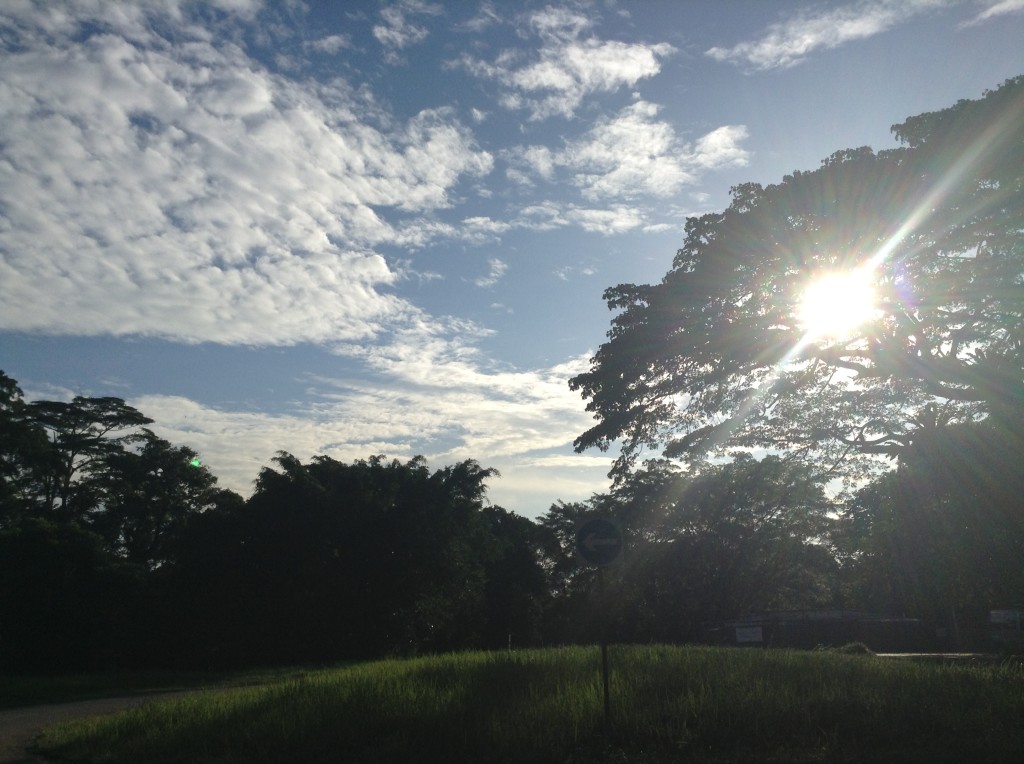
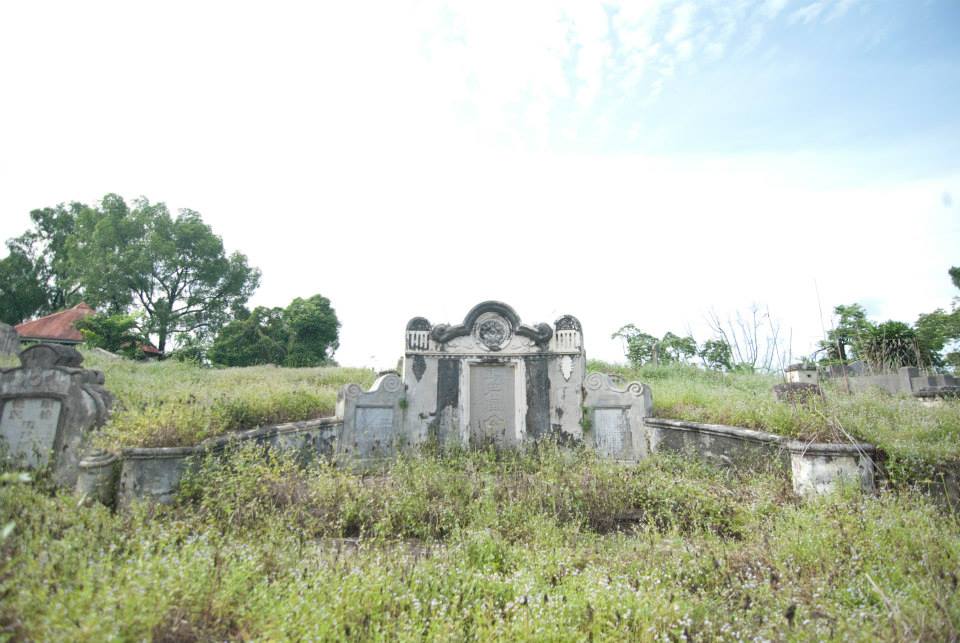

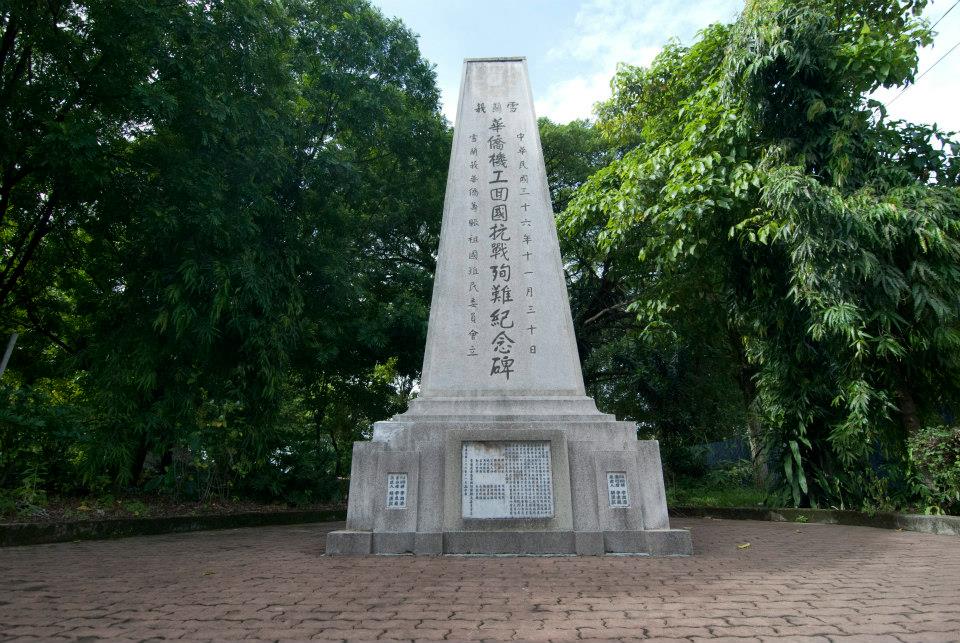
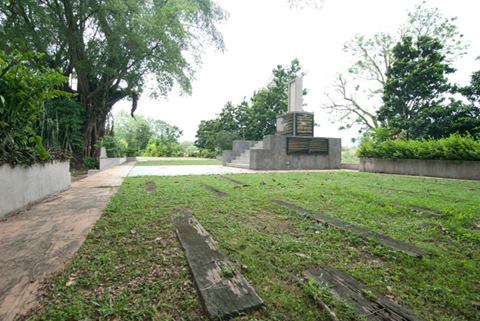
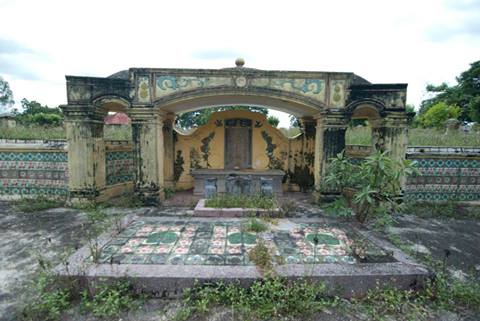
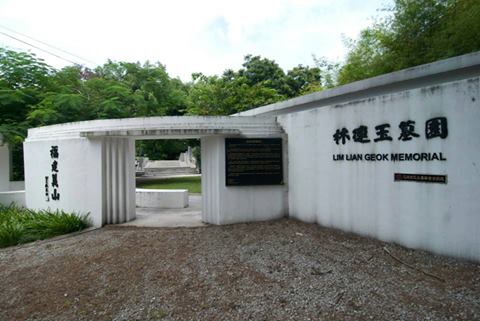


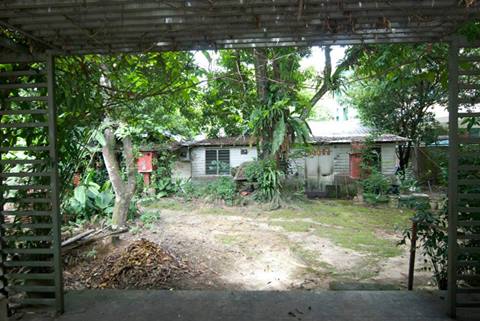
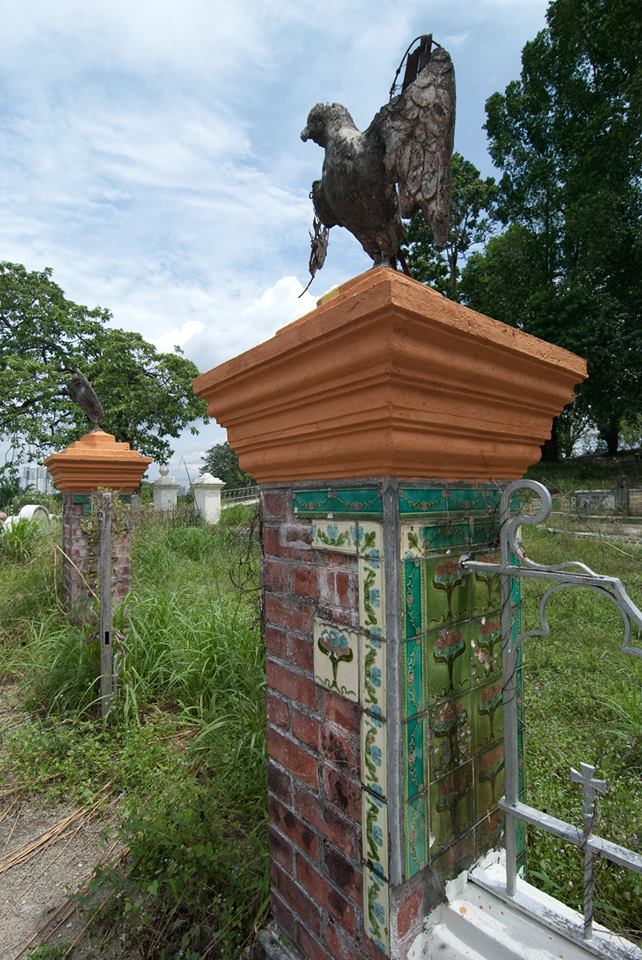


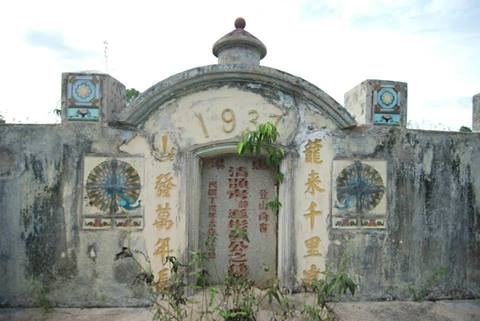

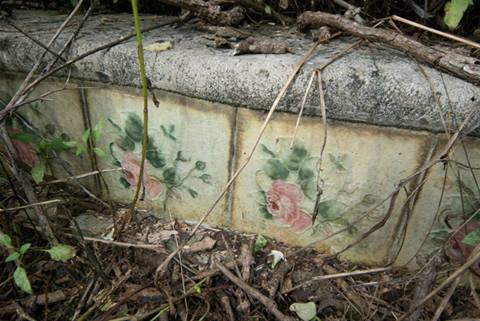
Recent Comments